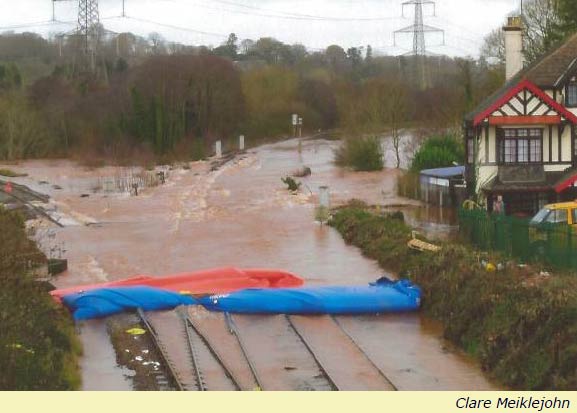>> Getting Back on Track >>
>> Bridge Strike >>
>> B.R. Totems >>
>> Running-In Boards >>
>> One Hundred Years since the Grouping >>
>> The Railway's War Effort at Christow >>
>> Beeching Did Not Shut the Teign Valley Branch >>
>> Christow Station Bridge >>
>> Ball Clay Mining >>
>> Main Line Diversion >>
>> There it was, gone >>
>> Behind-the-Scenes of the E&TVR >>
>> It can't or it won't be done? >>
>> Llangennech and Carmont >>
>> Position Closed >>
>> The Alamy >>
>> One Running-In Board Goes All the Way Home >>
>> Teign Valley History Centre >>
>> Conicity >>
>> Track recovery at Christow, 1959 >>
>> Heath Rail Link >>
>> Last Run of the Albion >>
>> Mountain Mine >>
>> The Permanent Way (and the Truth and the Life?) >>
>> Road-Rail Containers >>
>> Hixon—50 years on >>
>> D6331 >>
>> Exeter Railway Junction—Freight train departure >>
>> Newquay Branch—Descending Luxulyan Bank >>
>> David Shepherd, C.B.E., F.R.S.A., 1931 - 2017 >>
>> The Genus Grockle Automobilus >>
>> RAMBLES AROUND EXETER >>
>> Once Busy Bus Stops >>
>> Searching for Albion >>
>> Railway Nomenclature >>
>> Visit by the Dartmoor Railway Supporters' Association >>
>> The Railway - British Track Since 1804 >>
>> Exmouth Miniature Railway >>
>> DVD Review: Branch Lines of Devon—Volume 1 >>
>> A Very British Map: The Ordnance Survey Story >>
>> Charity HST Special, 10th October, 2015 >>
>> David St. John Thomas, 1929-2014 >>
>> Visit by the Dartmoor Society >>
>> A Strange Place to Find a Shipwreck >>
>> Bovey Lane Crossing Saved >>
>> Special Trains on the Moretonhampstead Branch >>
>> Dartmoor Society Public Debate, 2014 >>
>> The Buzz Tour >>
>> Caption Competition >>
>> The Dawlish Débâcle >>
>> Crediton Community Bookshop >>
>> Heathfield - Newton Abbot Community Rail Project >>
>> Visit by the Branch Line Society >>
>> The Temporary Booking Office >>
>> Class 142 Farewell >>
>> Teignbridge Sidings Reopened—in a way >>
>> The International Mining Games, 2012 >>
>> Cranks’ Excursion >>
>> “This Accommodation will Never Appear in a Colour Supplement” >>
>> Study into reopening of valley line >>
>> Kingskerswell Bypass >>
>> “Transition Tourism” >>
>> One of the last pictures of the Teign Valley Branch in operation >>
>> Signs Come Home >>
>> Cowley Bridge Junction >>

Yeo Valley Trust
Autumn Shareholders' Meeting 28th September, 2025
Only a month after the cashier at Christow had written a cheque for £2,000, payable to Exmoor Associates, C.I.C., the scout attended the meeting at which it was proposed, by way of a Special Resolution, to transfer shares in the Association to the Yeo Valley Trust, a charity formed to support the work of the Associates and one able to obtain gift aid and receive legacies.
The meeting was held in Meadow View Hall, part of the newly established Growforward Project which nestles beneath Chelfham Viaduct and incorporates the old mill that used to draw power from the Chelfham Stream, a tributary of the River Yeo.

The first part of the meeting concerned Exmoor Associates and the principal business was the poll of shareholders which asked them to vote for or against the Special Resolution. The voting slips had to be checked against the list of shareholders and so the count took some time. When the result was declared, of the votes cast, 95% were in favour of the resolution. The directors would decide whether to wind up Exmoor Associates or render it dormant.
The next part of the meeting dealt with Yeo Valley Trust affairs, perhaps in a little more detail than was necessary. Before the lunch break, a rousing talk was given by long-serving railway engineer, Bruce Knights, who was itching to lay the light track which was stacked nearby; and which the scout had seen on a lorry in August, parked at the road junction.
The scout and his pal sloped off after the buffet lunch to visit the station and walk the line towards Bratton Cross Bridge. By the time they returned, attendees were dispersing.
Such has been the cooperation between the Growforward Project and the railway champions that a visitor centre is devoted to a Yeo Valley Trust exhibition, including a rolling promotional video, which is all admirably presented. There is even a small bar.
The very friendly Growforward lady, who had greeted the scout and his pal on their arrival, served them large cups of tea with biscuits. The scout chatted at length with Mike Buse, who not only revived Woody Bay but also founded Exmoor Associates, which really are wonderful achievements.
What decided the Teign Valley to back this endeavour was the talk of building a railway which would not employ steam traction, or would be most unlikely to do so. Thus, possibly a step closer has been taken to the Swiss-style electrified railway that the Teign Valley always thought should serve Lynton and Lynmouth, long ago dubbed "Little Switzerland."
Getting Back on Track
Reviving the Teign Valley Line
In January, 2024, Prof. Geoffrey M. Hodgson of Dunsford wired the railway:
"This weekend I was in discussion with Andy Swain (Liberal Democrat councillor for the Teign Valley) and Mark Wooding (Liberal Democrat Parliamentary Candidate for Central Devon) about the possibility of re-opening the Teign Valley line. They are both keen to investigate this. I came across your highly informative website."
The railway replied:
"When Younger-Ross was prospective parliamentary candidate for Teignbridge, I often used to lobby him regarding the branch lines. There was no interest shown by Lib-Dems at the time.
"As it's very nearly ten years since the wall was breached at Dawlish, I am bringing my account up to date. I chuckled at a bit of my report on Network Rail's roadshow at Langstone Cliff."
"And there they were, the vain and the vacuous, lining up to deliver their well-rehearsed, but quite meaningless , lines. Even standing as close as he could, the scout found it hard to catch what Tory Clone, Painted Doll and an M.P. who had bought luxury furnishings for his London flat at taxpayers' expense, had to say—as if it mattered."
"The Okehampton revival gave the impression that government was seriously going to roll back Beeching, when in fact it will be joined by only a handful of other projects. In a mini mania, groups in Devon are pressing for the return of rail services to Bideford, Bude and Tavistock. I support them, all the while understanding the institutional deadweight that stands in their way."
Professor Hodgson is Emeritus Professor in Management at Loughborough University, London; Editor in Chief, Journal of Institutional Economics; President of the Darwin club for Social Science; Secretary of Millennium Economics Ltd.; Chair of the Teign Valley History Group; founder of the World Interdisciplinary Network for Institutional Research (WINIR).
Prof. Hodgson produced a draft report, with the option of a shared-use path instead of a railway, or as an intermediate stage, and circulated it among the group, which included Jan Rayment, a party officer, and Charles Eden, the Chairman of Holcombe Burnell Parish Council.
Mr. Wooding replied:
"An excellent document. My only question is does setting out an option for a cycle-way detract from the main point about reinstating the railway?
"Whilst this might constitute a fallback position I wonder if tactically it is better to maintain the focus on reinstating the rail line?"
Prof. Hodgson explained his reasoning:
"Andy's original suggestion to me was for a cycle way only. My response was to suggest to him a cycle way as a step towards re-opening the railway. When I researched the document, I became more and more convinced that the Teign Valley Railway is the best solution to the Dawlish problem (which will NOT go away). Colin Burges' Teignrail website is particularly persuasive on this, as is the paper with projections on future storm impacts at Dawlish.
"One advantage of keeping the cycle way as a transitional step, is that two big expenditures at each end would be postponed. These two big expenditures are (1) the Alphington-Ide rail link, which would involve some rebuilding at the A30 roundabout, and (2) the construction of the rail link aside the A38 from near Chudleigh to Heathfield. But the bridges would be rebuilt, and the tunnel repaired, making a continuous cycle route from Ide to near Chudleigh. Then, perhaps after the inevitable further closures of the main line at Dawlish, we could push for a completely restored Teign Valley railway.
"On the other hand, as you suggest, there is an advantage in pushing for the fully restored rail link now. This is a clearer and more focused objective. My worry is that the big expenditures at each end would stall the project."
The railway wired the "Friends," pointing out the difficulties in making a walking and cycling path, and questioning its real value.
"Establishing a cycle—or, properly, a shared-use—path in preparation for railway reinstatement would in fact result in little advantage.
"A path from Halscombe Lane to Trusham, which is about all that is possible, with detours onto main roads between Perridge (assuming Sir Harry would allow use of the Perridge carriage drive) and Horrowmore, and between Greenwall Lane and Ashton, would involve the land which was the easiest to obtain or the landowners who were the most amenable. Compulsory purchase is seldom used for leisure trails.
"Perridge Tunnel could be made safe by shotcreting, like Whiteball, but this would further reduce the rail structure gauge in what was a notoriously tight space.

"The tunnel would have to be lit between 0500 and 2300. Structural lining using concrete segments, which is what is really needed, would be far too costly for a cycle path to bear.
"The one missing bridge which could justifiably be replaced is Cotley Lane and this would be done with a lightweight span like those near Moretonhampstead.
"Once a path had been made, users would not want to lose it. Vague ideas of reinstating the lines between Barnstaple and Bideford, Okehampton and Tavistock, and Bodmin and Wadebridge were immediately opposed by walkers and cyclists, even though most come by car with bikes or dogs to an access point, whence to treat the trails as linear parks.
"With the exception of my 100 yards, nothing has been done; and I predict that nothing will ever be done.
"A Sustrans scout who joined by 2003 commemorative walk from the main line junction to Christow concluded that the route was only of value for heavy rail.
"The railway would be rebuilt under a Transport and Works Act Order with full powers."
In a reply to Prof. Hodgson, commenting on the first draft of his report, Andy Swain wrote:
"When we first discussed this, I was interested in the possibility of a cycle track, and that was my goal. There is as Geoff said the possibility of a walking track, requiring less engineering at the lost crossings, but also potentially a less valuable resource to justify the expense.
"To be honest the idea of reopening the railway had not crossed my mind, and I tend to agree with Colin that forming a cycle track or footpath, is exclusive with reopening as a railway."
Four links to relevant films on the railway's YouTube channel were sent to the group, along with itemized costs of the work on the main line, totalling £218-million. These costs were later referenced for Prof. Hodgson.
"In 2014, Network Rail priced a double line of railway along the Teign Valley route at £470-million, with a 66% contingency uplift. The price I got, assuming no N.R. involvement, was £180-million for a reinstated single line. Even N.R's. over provision had a cost-benefit ratio of 0.29, the best of the options. The "Borders" line in Scotland was given the go ahead on 0.5 (50p back for every pound spent) and has been a runaway success.
"I stand by what I wrote under "Coping with Perilous Exposure" in 2017."
"The danger is that far too much money will be spent on this line and that vastly better resilience than it has now will never be achieved. With worsening conditions, it is possible that no real progress will be made and all the while there will have been no attempt to create route diversity, once a great strength of the British railway system.
"Short of tunnelling behind the cliffs, no amount of work will make this route invulnerable: it only needs to fail in one place to stop trains. As this railway said after the Dawlish Débâcle in 2014: "The challenge is to ensure that the existing line has the greatest possible resilience, but to have readily available an inland diversionary route between Exeter and Newton Abbot."
Prof. Hodgson published a final version of his report, which made no mention of a path, on 14th February. It is, of course, merely an academic exercise but nonetheless welcome and useful.
Bridge Strike
Christow Station
Late in the evening of 19th October, 2023, a car struck the parapet of Station Bridge and caused severe damage.
Only the year before, £70,000 had been spent by Historical Railways Estate sympathetically repairing the structure.
An outpouring of anger was vented on the local chatter page, with a few suggesting that the driver may have consumed alcohol.

The crash was reported by the railway to the local beat bobby, P.C. Hawkins (13114) on 24th. He replied, advising that he could not create a crime report from a wired message. Others had the patience to use the proper channel.
On 25th, justified by five years of correspondence on the subject of drink-driving, a message was sent to the Police and Crime Commissioner. A reply came on the 1st November from Erica Harris, Customer Service Support Officer, advising that the matter had been passed to the Head of Road Safety within Devon and Cornwall Police for his attention. She added: "He has shared this with his team and asked them to take some actions such as patrolling in Christow over a period of time ... "
The following morning, no less than Superintendent Adrian Leisk (34247), Head of Road Safety, got in touch.
"Thank you for your email expressing concern around Devon & Cornwall Police's approach to drink driving in the Teign Valley."
"We have an active operation (Dragoon) to identify and take action against those who pose significant risk on our road network. This includes drink and drug drivers.
"We have a No Excuse team, consisting of a Sgt and 5 constables based in South Devon who use marked and unmarked cars, equipped with Automatic Number Plate Recognition (ANPR) cameras to tackle those above drivers who pose a risk on our road network.
"If you are happy to provide any specific intelligence around the drink driver, I will ensure that this is submitted on the system and shared with the No Excuse Team Sergeant."
The railway was able to provide some "specific intelligence."
Who says that authority never acts quickly? A few days after the incident, an engineer came to examine the bridge and only eleven days after it was damaged, framework contractor, Hammond from South Wales, on behalf of the authority, closed the road for a fortnight so that repairs could be done in safety. This caused a great deal of inconvenience, not least to bus passengers, as the No. 360 had to be diverted.
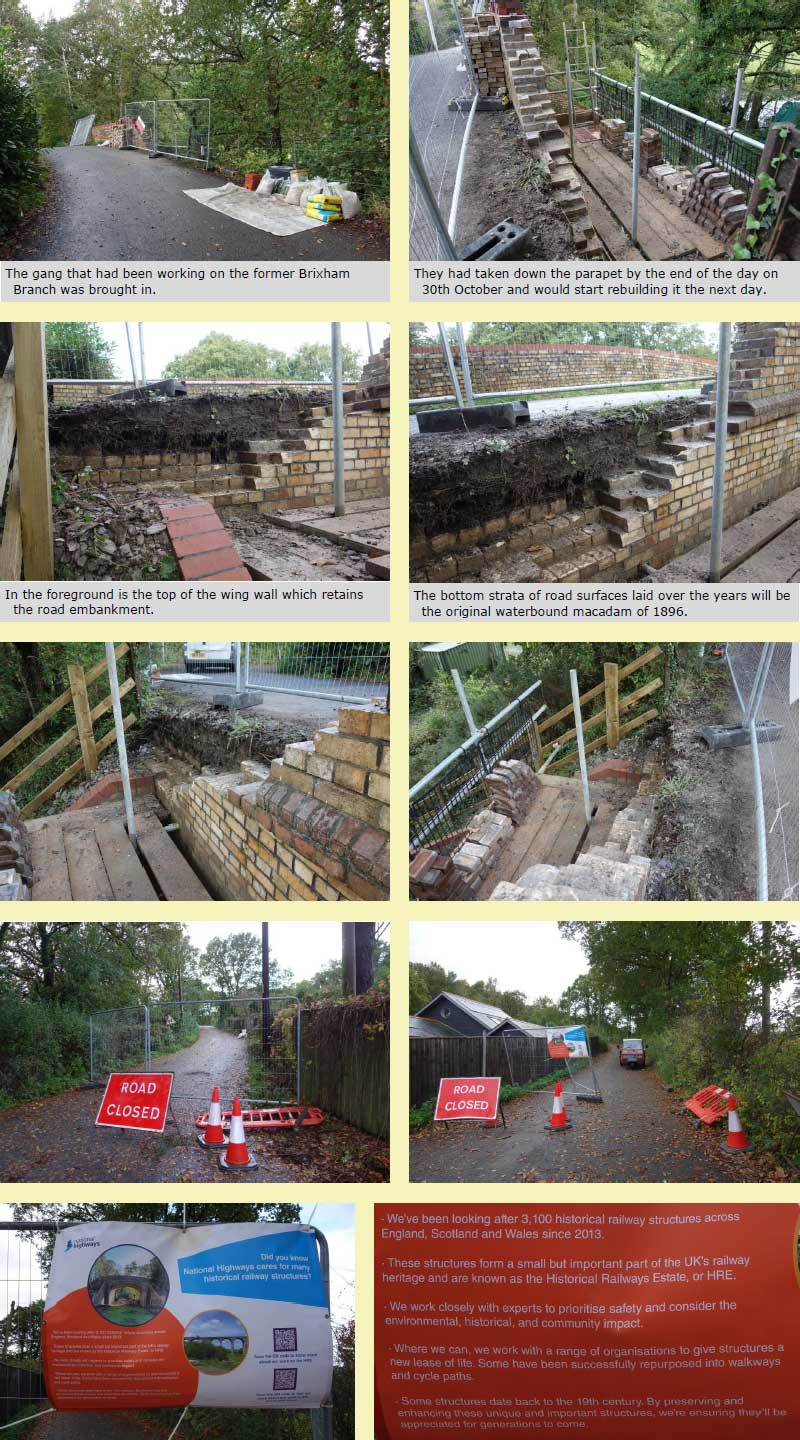
After the fiasco with Great Musgrave in Cumbria, where a retrospective application to infill the bridge was refused, National Highways was anxious to rehabilitate itself and seemed to have chosen Christow Station Bridge as an exemplar of its newfound, responsible approach.
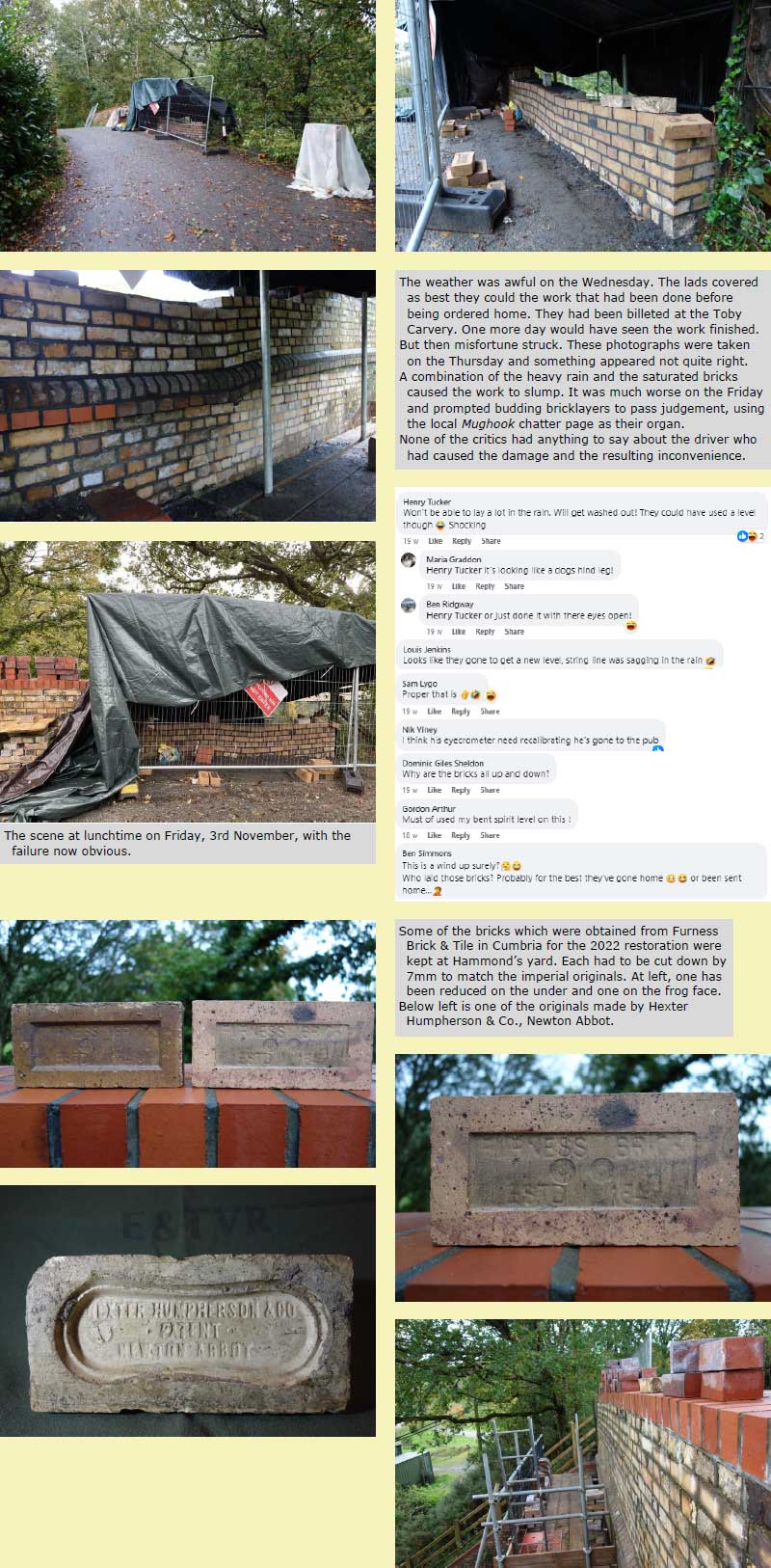
The gang returned on Saturday and took down what had been done. On Monday, 6th November, the work was finished and the road was reopened.
February, 2024: A Freedom of Information Request was submitted to National Highways through the web channel: "Please advise the amount that was spent repairing the damage caused to a parapet of this bridge after it was struck by a car on 19th October, 2023. Please advise whether the amount is being claimed from the car driver's insurance."
The answer came on 19th: "The repairs cost £25,472.98 and the process is being followed to recover this from the driver's insurance company."
March, 2024: This information was sent to Superintendent Leisk, along with the observation: "The other regular offenders I thought may have shown some caution after this prang, but it appeared that drink-driving carried on being a laughing matter locally."
No reply was received.
Followers of the "Teign Valley Railway" Mughook page were told how much the repairs cost in a brief post, finishing with: "It is noticeable that the valley mob, which is viciously critical of cyclists legitimately using the public highway, is silent about the area's habitual drink-drivers."
B.R. Totems
When the Teign Valley procurement officer visited longstanding railway supplier, Rydon Signs at Pinhoe, he saw the large orders wrapped and ready to be dispatched to places on the national network and felt it rather feeble that he only wanted one small totem. So, as he entered the design and print room with Dave Rossetter, the very helpful General Manager, he boldly blurted out: "Make me four."

The signage for Marsh Barton was seen propped against a wall while Matt the designer put the "double arrow" on the computer screen with "Christow" beneath it. Dave asked what the other stations were to be and was told with only slight hesitancy: "Bideford, Bude and Tavistock."
As a show of support from the Teign Valley, the three signs were handed over to representatives of the local campaign groups at Okehampton Station on 20th April, 2023.
The signs are intended to be used as "stage props" and in publicity. They could have been made less expensively but it was thought that they would carry more weight being the "real thing."
They have the original "double arrow" and rail red colouring. The lettering is in Rail Alphabet, introduced in 1965 as part of the new British Rail Corporate Identity.
In 2020, Rail Alphabet 2 was adopted by Network Rail for new signage and this will become standard for Great British Railways, if it is ever born.
The British Rail double arrow is one of the most enduring and recognizable corporate symbols, now slightly modified for the digital age. It was first sketched by its designer, Gerry Barney, on the back of an envelope while he was going to work on the tube.

All four stations were closed after Corporate Identity was established. Now that the signage is done, all they need to do is rebuild the railways.


Running-In Boards
The story of how two original running-in boards had returned to the Teign Valley is told in full under "Signs Come Home."
Using the only close-up views of "CHRISTOW" as a guide, simple frames were made out of meranti. The mouldings were beefed up a little to correct the bowing of the enamel panels, possibly caused in the kiln.
Lengths of moulding were left over, enough, it was estimated, to make an "IDE," once the shortest station name in the country.
And still there was a bit to spare, enough for a short side of another "CHRISTOW." As making this would complete the set ordered by the Exeter Railway for the opening of the line in 1903, some more meranti was ordered.
The replica signs have powder-coated aluminium panels with lettering cut from vinyl, printed to match the originals. They were then varnished to give the appearance of enamel. If more panels were made, the printing method used by Rydon Signs to make the B.R. totems would be used. This gives the lettering a slight relief.


One Hundred Years since the Grouping
Who has not come across a £5 Premium Bond at the back of a drawer, perhaps dating from childhood? Anyone who bothered to check would likely find that it had never won a million—or even a pound—since it was issued.
At least Premium Bonds are redeemable at face value, unlike share certificates.
The beginning of the "Big Four"
At the outbreak of the First World War in 1914, the railways were taken under government control and this was not relinquished until after a means of reorganizing the system and its ownership had been decided, which would allow the supposed benefits of wartime unification to continue.
As a compromise, instead of nationalization, the Railways Act of 1921 established four group companies which were to absorb nearly al the existing British railways, owned by 119 companies. The Great Western Railway was the only original name to survive the grouping.
The other three, London, Midland & Scottish, London & North Eastern, and Southern, absorbed very extensive systems with old names. Of the 26 "constituent" companies, five were grouped with the Great Western, the largest being the Cambrian. The remainder, "subsidiary" companies, included small, local concerns like the Teign Valley and Exeter, often only remembered on paper.
Compensation for shareholders was based upon lines' earnings in 1913, the last year for which figures were available. This suited the Teign Valley company very well because 1913 had been its best year.
The Exeter company, however, would not settle up without an argument. That it caused the Great Western more trouble than any other may have been partly due to the Exeter being a young company, whose line had been operating fewer than twenty years. The company made the case at the Railways Amalgamation Tribunal that, due to its burgeoning stone traffic, revenue was considerably in excess of the pre-war level. The Tribunal upheld the position of the E.R. by recommending a higher value for the company than the Great Western had been prepared to pay.
This was accepted and the way and works of the Exeter Railway, along with those of the Teign Valley Railway, became part of the Great Western as from 1st July, 1923.
Both the Teign Valley and Exeter companies had eventually managed to service their highest priority debentures, and holders of these received G.W.R. 4% debenture stock at par. The rest of each company's value in shares or cash was distributed according to proportions decided by the boards.
Neither company ever paid any dividends to ordinary shareholders, who had long been resigned to the knowledge that their stock was near worthless. The descendants of plump parsons and wealthy widows, who, in the 1870s, had eagerly bought £20 T.V.R. shares, received 21s. (£1.05) in cash for them in 1923. Likewise, Exeter Railway ordinary shareholders received one twentieth of their stocks' nominal value in cash.
The E. & T.V.R. continues the noble British tradition of pouring money into the bottomless pit of a railway project without any hope of a return.


Nationalization finally came, after another world war, in 1948. Forty-six years later, the state threw the railways back to the private sector and created a disintegration that was far worse than existed before 1923.
B.R. ceases to be
The fag end of nationalization has finally been snuffed out.
Further to the brief item on BRB (Residuary) Ltd. included in the Perridge Tunnel pages, it can now be written that the organization was disbanded in September, 2013, and its functions transferred to a number of existing bodies.
Most of the Historical Railways Estate (formerly known as the Burdensome Estate) was passed to the Highways Agency (of all people). Other responsibilities and liabilities were taken on by London & Continental Railways Ltd., Network Rail, the Rail Safety and Standards Board and the Department for Transport. Included in the transfer were the quaint "Rights to Wreck," a residue of the railways' complete transport system.
Thus the people's railway that began life in 1948 vested with 20,000 locomotives, 55,000 carriages, 1¼-million wagons, 12,000 lorries, 123 ships, 35 hotels, 650,000 staff, over 8,000 stations and enough track to stretch more than twice around the equator, very nearly all financed by private investment with very little help from government (arguably, the railways had actually subsidised the state), ended up in 2013 with its remaining baggage being thrown out or given away like the few tatty possessions of a poor, forgotten soul after a funeral.
The Railway's War Effort at Christow

Eighty years later
Anyone could be forgiven for thinking that this official new works' photograph merely recorded the normal expansion of railway facilities, in the days when rail transport was the predominant mode.
Nothing in the photograph reveals that the world was actually in the grip of war, which brought death and destruction from the skies above England.
Enemy bombers were often to be seen flying low over the sand bar at Dawlish Warren and up the Exe estuary, on their way from occupied France to attack Exeter or perhaps other targets.
The main line which they flew right beside, a vital supply route for the naval base at Devonport, was naturally considered vulnerable and, for this reason, the Teign Valley Branch (like many other secondary lines on the G.W.R.) was kept open continually, night and day, from 1941 to 1945. The branch's usefulness in an emergency—even a peacetime one—was severely limited because of the track layout at stations, and so the line was included in a government-funded programme of "Insurance Works" for increasing the capacity of diversionary routes.
By the time this photograph was taken, the tide of the Second World War was turning in favour of the Allies. The Russians had taken back Stalingrad in January; the Axis forces in North Africa would shortly surrender; Japanese advances in the Pacific had been checked. And in the Atlantic, the U-boat menace was being countered, which would enable the American build-up to commence for D-Day.
In not much more than another year, then, the threat which prompted this work at Christow was to pass.
The Works
Nowhere on this inland route between Exeter and Newton Abbot could a fifteen-coach train make an uncomplicated crossing with one travelling in the opposite direction. The only passenger loop on the Teign Valley section was at Christow and it was meant only for the light traffic of a country branch line. Furthermore, even at the junction with the Moretonhampstead Branch at Heathfield, where there was a long loop, two diverted trains could not cross without shunting because of the junction layout.
To remedy this incapacity, the 1943 improvement works entailed a new Down goods loop at Longdown, an extended loop at Christow, conversion of the goods loop at Trusham and the laying in of a double junction at Heathfield.
The total estimated cost was £31,047, of which £6,669 was to be spent at Christow.
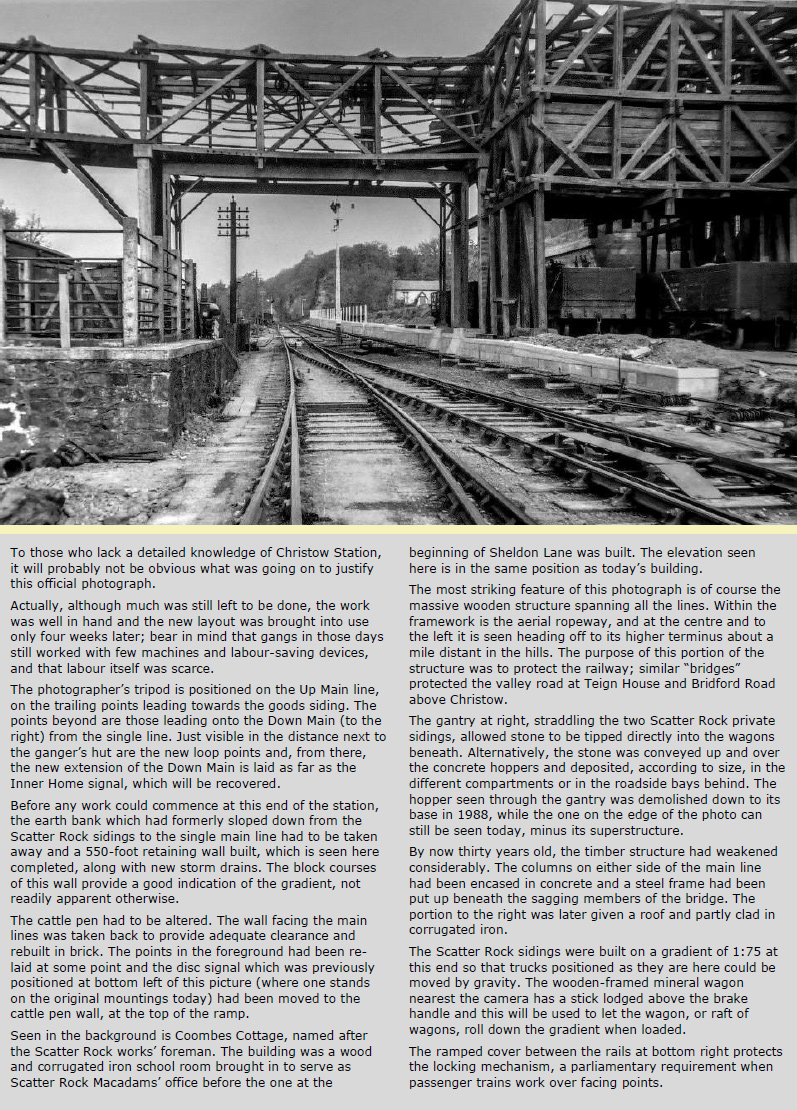
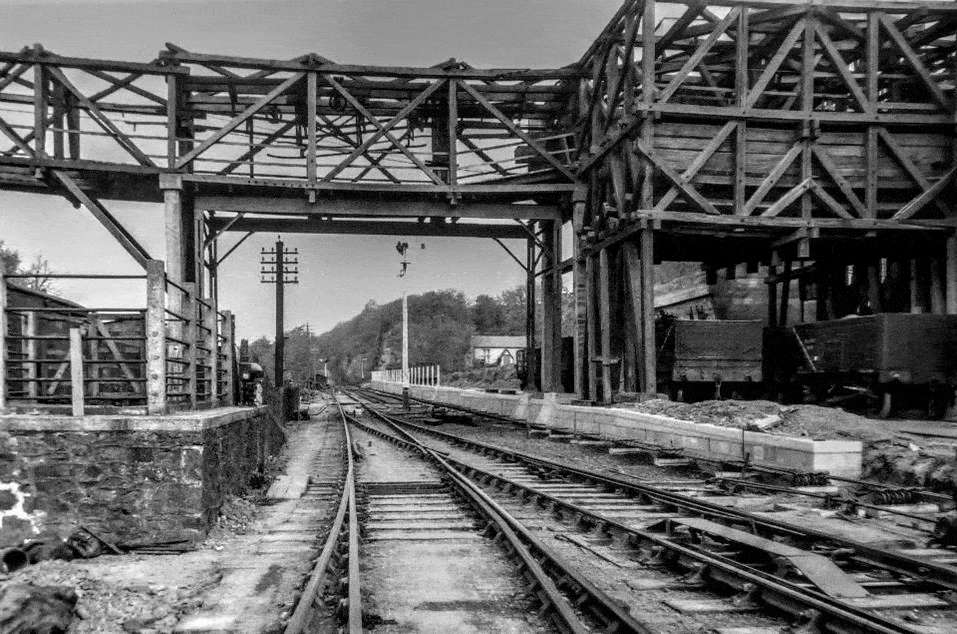

Beeching Did Not Shut the Teign Valley Branch
Sixty years since the "axe" was wielded
By the 1950s, it looked as if many branch railways had had their day and there was a mood of resigned acceptance as steps were taken to close them. When the closure programme became one of full-scale retrenchment in the early 1960s, the public was reassured by the simplistic analogy, "pruning will encourage new growth."
But as time went on, and the point at which contraction would produce a viable industry somehow could not be found, it became clear that the railway was like a giant organism and that no part of it could be harmed without affecting the whole. Those who embarked upon the process of "reshaping" made the mistake of isolating parts of the railway, not realising that all of its activities were to some degree interlinked and inter-dependent; this is charitably assuming that the pruners did not act with a hidden purpose.
On 27th March, 1963, the report which came to be known as the "Beeching Axe" was published.
The railways had been making cuts in the 1950s—the closure of this branch in 1958, and those to Princetown (1956), Moretonhampstead (1959) and Ashburton (1958), provide ample local evidence—but Beeching at a stroke said that territory and activities where the railway could not pay their way should be abandoned.
Cynics and, increasingly, real historians, claim that destroying the railway's universal service was necessary to justify the massive expansion of road transport which ensued.
The report was not concerned with environmental impact; it took no account of the social and cultural value of the railway system. Beeching did not have to look to the future and explain how the usurper would be powered when the era of cheap oil was over. And no one has ever reckoned up how vast was the capital thrown away.
In Devon, the destruction began in earnest with the closure of the Princetown Branch in 1956 and finished with the withdrawal of passenger services between Exeter and Okehampton in 1972.
Over 400 route miles and more than 200 stations were lost from the network in Devon and Cornwall alone.


A facsimile in hardback of the original report is available from the Gift Shop at Christow Station.
All the Stations includes lists of the existing and former stations in Devon, Cornwall, Somerset and Dorset.
Lord Beeching was interviewed in 1981 by the B.B.C. in Hindsight.
Part 5 of a ten-part Channel Four series, broadcast in 1984: Losing Track: Beeching
"Creeping closures": This Week, 1969.
A poet gives his view of road and rail in this film clip.
The Railways Archive has made available scanned versions of the Report, which is in two parts:
The Reshaping of British Railways - Part 1: Report
The Reshaping of British Railways - Part 1: Maps
The Archive also has these critiques of Beeching's work:
The destruction wrought by the "Reshaping" was greatest at the extremities of the railway system. What did it mean for the ordinary railwayman?
Stephen Derek went to work in the Divisional Superintendent's Trains Office at Exeter Central in 1960, when it was very busy with the organization of a wide range of complex functions, delivered in the traditional Southern style.
Well within the decade, he saw the loss of almost the entire network beyond Barnstaple and Okehampton, the closure of all except the Exmouth Branch in East Devon and the main line reduced to a secondary, singled route. Was there the slightest indication that this was to come in 1960?
"I can certainly say that when I joined in 1960, there was no hint that it would change beyond all recognition within ten years. Train services were still being expanded: the Cleethorpes service; extra locals, Exmouth-Budleigh; the 5.45pm Exeter Central to Exmouth non-stop "business express"; Surbiton-Okehampton Car Carrier; the accelerated ACE [Atlantic Coast Express] How we just thought it would last."

Christow Station Bridge
More on the cost of keeping disused railways disused.
Scaffolding was erected in September, 2022, and work started on maintenance which it was said would occupy a specialist gang from South Wales, accommodated in Exeter, two weeks.

On 4th November, after seven weeks' work by contractors, the site was deserted.
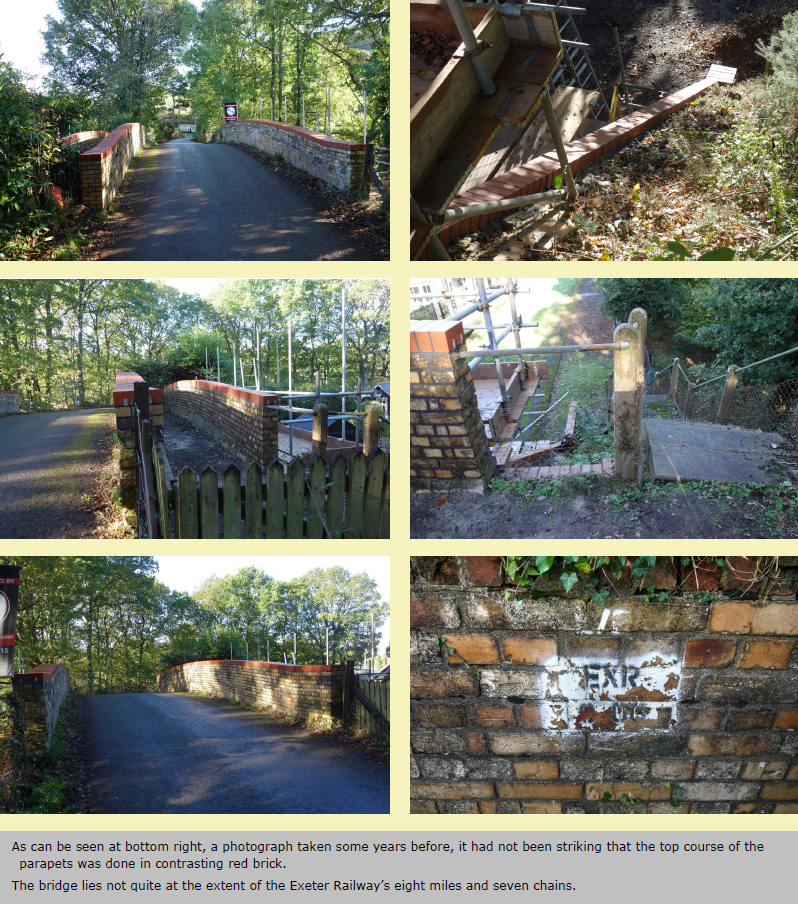
https://www.highwaysindustry.com/national-highways-give-bridge-a-yellow-brick-facelift/

The bridge was actually completed in 1896 by the Exeter Railway. The original road around it continued to be used, with a level crossing of the contractor's line from Teignhouse Siding. The money had run out and work was stalled. The bridge was to stand for seven years before the first service trains ran beneath it.
The second image in the article above is reversed: the steps are on the left, the Downside.
The unique wording of the potted history of the line is taken from "The Railway" found on these pages.
https://www.devonlive.com/news/local-news/historic-devon-road-bridge-back-7855262
On 8th March, 2023, a letter was sent to Hudson House, York, requesting the costs of work on the bridge to be revealed under the Freedom of Information Act. When no acknowledgement was received, the letter was repeated on 28th March. A newspaper article explains why nothing was heard from National Highways.
https://www.yorkpress.co.uk/news/16421348.demolition-nearly-finished-york-office-site-hudson-house/
In a Freedom of Information Request submitted through the web channel, two questions were asked of National Highways Historical Railways Estate: How much has been spent on the bridge since 2000? How much of this was spent on the repairs done in 2022?
The answers were: £105,020.49 and £69, 269.13.
Response from National Highways: Christow Station Bridge EXR 8.06
Work like this would normally have gone unreported. It is thought that the publicity given to this structure was very much the authority trying to redeem itself after the fiasco in Cumbria.

Ball Clay Mining
A seldom seen and lesser-known South Devon industry
Fascinated by what could be glimpsed from the road of the two-foot lines leading underground, in 1990 the Teign Valley scout went to the Watts, Blake, Bearne & Co. works office and spoke to the Mine Manager, who very kindly arranged for the scout to be taken individually on a tour.
Jim Wormald, who had managed enormous coal mines in South Africa, described Kingsteignton as "user friendly." There was no dust or water and it was comfortably warm.
The adits were arranged "herringbone" fashion, with side tunnels leading from a main drive. One man controlled the winch at the surface; trains were raised up a covered incline to the upper floor of a steel-framed building, where the trucks were tipped. Another man was at the underground junction, where a winch hauled the train from the side tunnel being worked. At the face, two men worked the crawler cutter, which fed the clay back to load successively a train of four trucks.
Every two feet or so, another steel rib, in two parts, was installed and three-inch thick larch boards were inserted. All these materials and the ventilation ducts were brought, and then recovered, using adapted trucks.
A surveying line in the roof kept the tunnel on course; the scout was shown a plan of all active and old workings over a very large area.
Once the train was loaded, the men had to wait for it to return empty from the surface.
The Mine Foreman also took the scout to see more-modern 2'-6" wagons being discharged automatically at the head of another adit. One of these wagons and a cutter, donated by Ball Clay Heritage, stand on the roundabout at the end of Clay Pits Way in Kingsteignton.
Afterwards, the railway was given two of the antique wagons which the firm had used before the steel tippers were obtained.
A brief description of Ball Clay Mining accompanies one of these wagons on open days.

Mining enthusiasts in Catalonia: Mountain Mine
Nearby, E.C.C. [English China Clays] Ball Clays also mined the Bovey Basin using quite different equipment. Operation had ceased by the time the railway recovered a large quantity of wagons and track sections; the latter were quickly put down along a path by the river.
Only one wagon underframe survives at Christow but the rails by the river were later released from their flat steel ties, straightened and re-laid on steel and wooden sleepers.

The Purbeck Mining Museum is at Norden Station on the Swanage Railway.
The Ball Clay Heritage Society is based in Newton Abbot.
The International Mining Games were held in Kalgoorlie, Western Australia, in 2023.
Main Line Diversion
Not, unfortunately, the "Limited" or a U.S. ambulance train
Until recently, no photograph of a diverted train had ever come to light. But then Mark Chambers, the well known Teign Valley enthusiast and historian, grandson of Revd. Wilbert Awdry, no less, acquired this and has been kind enough to share it.
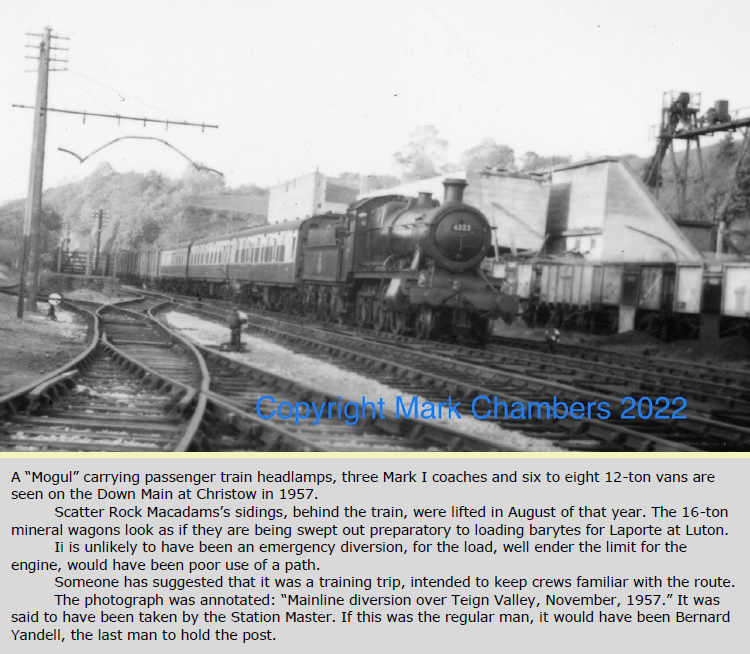

There it was, gone
Blowing up a bridge

Less than 20 years after government had paid for improvements to the line, Royal Marines were called in to blow up the bridges. This is the second of the two accommodation bridges between Ide Lane and Polehouse.
The demolition was also recorded in a short film.
https://player.bfi.org.uk/free/film/watch-royal-demolition-1962-online
In 1986, enquiries were made about blowing up one of Scatter Rock's concrete hoppers at Christow. The Royal Engineers advised that they had no explosives and the Royal Marines Warrant Officer who came to look at it said that the structure was much too close to properties.
Thirteen of the 21 masonry bridges remain between Exeter and Heathfield. It had been 22 until Greenwall Lane Bridge was destroyed in 2013. Happily, Christow Station Bridge was lovingly repaired in 2022.


Behind-the-Scenes of the E&TVR
In late September, the E. & T.V.R. was delighted to receive Joseph Rogers (Railfan-Joe) and guest, the legendary Danny Scroggins, at Christow for a tour of inspection.
Joe was kind enough afterwards to pen this report for "We Are Railfans."
https://www.wearerailfans.com/c/article/exeter-teign-valley-railway
It can't or it won't be done?
Overcoming the incursions
It is often claimed that the obstruction of the Teign Valley line in two places by major road building in the 1970s is insurmountable.
Some quick doodling shows that the obstacles could be avoided, if the will existed.
It is not going to happen because government has plumped for electrifying the road system and like-for-like replacement of vehicles, in preference to redeveloping widespread public transport.
After the Dawlish Debacle, consultants estimated that the civil engineering involved in reinstating the Teign Valley could have been done for £180-million. Roughly £30-million of that was getting round the A30 incursion; £30-million was for the structural relining of Perridge Tunnel; and £30-million was for a new formation alongside the Chudleigh Bypass.
Although the overall figure would now have to be revised, the latter amount is comparable to the £33-million being spent widening the A382 between Newton Abbot and Heathfield.

Llangennech and Carmont
A closer look at two recent mishaps

From time to time, staff at Christow read railway accident reports, either in brief or in detail, as these not only cover actual circumstances and events, they also provide a useful portrayal of modern developments and practices, and reveal much about the state of the system.
Those mishaps that result from simple human error, or design or procedural failure, are the easiest to read, as the report can often only recommend tighter observance of existing rules, or minor changes to equipment or systems.
Some, though, expose huge and fundamental shortcomings or weaknesses which have crept in over the years or have come about as a result of a shrinking and less purposeful railway.
Two recent reports have excited the General Office; one because it brought home how unseen trains can be and the second because of lost versatility.
The approach here differs markedly from that of the Rail Accident Investigation Branch, in that more questions can be asked and more background detail can be dwelt upon, which would be outside the scope of investigators.
They must forensically establish what led to the derailments but in so doing it seems that they overlook the small, human interventions that could have been made. Perhaps the branch chooses not to look too closely here for it may lead towards laying blame, which is not the purpose of the investigations.
Hindsight has not been used to conjure up flukes: the trains may have been saved by ordinary actions which were quite possible.
Brief correspondence with R.A.I.B.
September, 2023: Network Rail Infrastructure Limited pled guilty to a contravention of Sections 3(1) and 33(1)(a) of the Health and Safety at Work etc. Act 1974 at the High Court in Aberdeen.
The track authority admitted that it failed to ensure, so far as was reasonably practical, that railway workers not in its employment and members of the public travelling by train were not exposed to the "risk of serious injury and death from train derailment" as a result of failures in the construction, inspection and maintenance of drainage assets and in adverse and extreme weather planning.
On 8th September, Network Rail was fined £6.7-million, the highest financial penalty ever to have been levied on the state-owned body for health and safety failings. Judge Lord Matthews said the fine had been reduced from £10m because Network Rail had admitted culpability on the first occasion the case was called in court; it had taken actions immediately following the crash to improve health and safety standards, and was a publicly-owned body.
Weeks earlier, £14-million in fines had been handed down in the case of the Croydon tram crash.
Position Closed

Rumours that plans were afoot to close all booking offices sparked protests in August, 2022.
Just after eight in the morning on 23rd August, the scout joined the protest at the front of St. David's Station and greeted the six-or-so already there. No active staff took part and it was a pretty poor show for a union initiative with the backing of several other interdenominational organizations.
Dee from The Bookery walked up. The scout asked her if she had caught the train from Crediton and she looked sheepish. A message later explained why she had had to drive to St. David's.
It wasn't long before a First manager appeared and asked everyone to move to Bonhay Road, declaring that it was a union protest and therefore could not take place on railway property.
The scout had a go at him: "Hainsey, Tubby Hopwood, Bare-Arsed Shapps, Councillor Ginge and assorted "celebrities" were there to reopen Okehampton but on the first working day not a helpful face was to be seen as some intending passengers wandered around in a daze, being unfamiliar with rail travel. The problem with the industry is that it has a bloated and duplicated management and a support industry which is like a huge limpet."
This was received with the same blank look that people say they get when it is pointed out that the offering at a fast-food establishment, when it comes, is much smaller than the illustration on the menu had suggested. The rail manager, who looked like he enjoyed fast food, strutted about with a walkie-talkie to his ear, as if to emphasize that he was only following orders from his superiors.
The scout made to go but one militant said that he intended to stay. Manager man, who claimed to understand the protestors' purpose, said he would have to get the police and ten minutes later two constables emerged from the Post Office entrance.
Before they could speak, the scout came out with: "You know they'll be coming for you after the booking offices have gone, don't you?" When the lead officer spoke, the scout diverted from the issue: "Is that a faint Irish accent I detect?"
"More than faint, I hope," he replied.
"Southern Irish, I would say. Do tell me the county. No, let me guess."
Eventually, he got a word in and asked the protesters to move beyond railway property. As he was being decent, the scout thought it best to go; the others followed. The P.C. came as well and opposite the Windsor (the former hộtel) he answered the question: "Limerick." If the scout had been clever, he would have come up with a verse appropriate to the occasion. The constable, suddenly becoming human, said that he was concerned about losing guards on trains and was sympathetic towards the protest. He had been with Surrey Police and wanted to transfer to Devon & Cornwall but the interview was delayed and he joined the Transport Police instead, which involved a short conversion course.
Passengers taking leaflets were mostly pleasant and open. The harsh reality is that many of them would have bought their tickets elsewhere. The challenge for operators bent on relentless cost-cutting of passenger-facing staff is to provide for the diminishing number of passengers who still choose to go to a booking office window to buy a paper ticket or to enquire about train services. Others may need assistance occasionally, such as when their portable telescreens have gone on the blink.

After a while in the less advantageous position away from the station frontage, the group walked to Central Station. A lady introduced herself as Rebecca. She looked very young but told the scout that she was forty. She had been involved with all sorts of activities and was very politicized. Holding a doctorate, she ran a course at the university; the subject went mostly over the scout's head until she mentioned the 19th Century "Rebecca" protests against turnpike tolls.
The two coppers drove to Central, perhaps to check that the group had not strayed beneath the canopy; the scout had promised that it wouldn't so that the law lads could have their breakfasts undisturbed.
After the others dispersed, the scout continued talking to Rebecca for what must have been nearly an hour. She had said that she was off on holiday to Majorca and the scout had asked her if she had heard of the Flight Free campaign. She said that she would have very much preferred to travel overland and the scout advised that there were agencies who would help, or even who specialized in such journeys. She did not drive; her partner, working in the coffee shop there on the Crescent, could drive, but did not. Even after the scout had shaken her hand and said "cheerio," the conversation continued.
Of course, he had to point up at the place where "SOUTHERN RAILWAY" once stood out from the stonework and to the valance where principal destinations were displayed on the green glass: "BOURNEMOUTH," "BRIGHTON," "BUDE." Actually, Bude may not have been there. "You can have no idea what once went on here," the scout said.
Earlier, the scout had thought he would catch the 0919 to Barum, but when he got away it was gone ten. He could have caught the next one from Central but shot down the hill. He went to buy a "priv" return from the window to show support but, laughably, there was a queue. So he handed leaflets to those waiting and scarpered, lest manager man reappear and shout: "Oi, I thought I told you ... !"

The scout bought his ticket on the train, after telling the guard what he had been doing. They chatted further at Eggesford, when the scout asked for the train to be stopped at Umberleigh. The guard, who had recently graduated from the gateline, estimated that about 70% of passengers bought their tickets beforehand.
Later, after visiting the Cobbaton Combat Collection and climbing Codden Hill, the scout had a chat with the ex-Civil Service booking clerk at Barnstaple, who had been on his own because of sickness. The scout gave him a leaflet and discussed the issue with him. He told the scout that a manager had come to Barnstaple the other day but the clerk had been too busy to give his boss any attention.
Vague ideas about a new, flexible role for displaced booking clerks circulated in 2022, one of the causes of the labour dispute. As High Street shoppers have resorted to the worldwide web, so have passengers: as many as 90% have now bought their tickets before they get to the station. The one member of staff on duty at small stations has long been versatile, only spending part of his turn behind the window. When the scout chatted to the clerk at Yeovil Junction first thing on a summer's morning, the friendly and conscientious fellow was litter-picking in the car park. The man at Barnstaple had been tidying the station and was about to lock the toilets.
Versatility has long been a notable attribute of Teign Valley staff, each member of which is qualified to do at least four jobs.
The Alamy
Staff at Christow is used to seeing men come to take photographs or numbers in pursuit of their peculiar pastime. Sometimes they will approach and engage in brief conversation, but usually only to ask where a particular vehicle in their spotter's book may be found. Others will try to avoid contact. Some do "drive-byes" on the lane overlooking the yard, perhaps thinking that it is a public road. They may claim that they have happened upon the place and, in snapping away from the doors of their cars, they are doing no more than curious passers-by would do. In fact, it is a private road that leads no further than the gate of a retreat.
The funniest are the men who bring their wives and after having had the greatest difficulty in cajoling their agreement to the visit in the first place, then have to promise them that they will not dwell for long. The frumpy wives nearly always sit in the cars looking glum, without so much as winding down the windows or getting out to stretch their legs. The river, a draw for most, would probably hold no appeal even if it were pointed out to them that they may catch sight of otter or kingfisher. Staff likes to pounce on these fellows and hold them up while they are out of sight of their dearests, for this soon causes their walkie-talkies to ring. "It's her; she wants to go shopping," they say, as they feel the marital chain pull tight.

A few—sadly, a very few—are interested in more than just taking numbers and will happily talk like normal men on a range of subjects, or at least discourse in depth on their special interest.
Most of the pastimers are too mean to put a farthing in the contributions box; they must tell themselves that nothing has been bought and no benefit has been received; therefore no obligation is felt.
But, they have deliberately sought out the project and it must therefore be a part of their interest. The fact that the things they follow have been saved from being broken up, or have been expensively repaired, and lie in an appropriate setting for enthusiasts to see is a kind of offering which ought to be valued.
By all accounts, this fraternity is generally mean. The pickled railways complain about those who just want to observe or take photographs but who refrain from paying fares or buying a book in the shop or a sandwich in the caff. This type will not consider it a duty to help support the provision of the entertainment, whether it is seen as moving spectacle or in a static form. Similarly, a great many now expect to enjoy music, films and other artistic or intellectual property without making any contribution towards its creation.
Thankfully, at Christow, a small number of visitors are generous—some exceedingly so—which makes up for the natural spongers. It is human nature for some to see no gate or restriction or admission charge as a gift and for others to feel trusted to do what is right.
The discovery on the photographic library, Alamy, of a batch of shots taken at Christow has revealed another category: those who are not content to visit the project and point their cameras, but intend also to offer their work for sale.
The photographer, Andrew Payne, who seems from his choice of subjects to be a local fellow, has done nothing wrong. He took his pictures from, or close to, the public footpath which crosses the railway and there is no law, and little etiquette, governing what can be done with a camera at a public place, more is the pity.
But the work at Christow has involved an enormous expenditure of time and effort over many years. Wresting the railway back from nature, clearing the ground, laying the tracks, bringing in vehicles, putting up buildings and furnishing the place has cost the men responsible for it dear, but has brought them little in return.
Those who take photographs for their own enjoyment or for sharing, though they may not think of contributing even the token amount that most visitors would put in the collection box of an empty church, can be ignored. However, someone who photographs the work, in small part for his own enjoyment, but also with the thought of gain, rather annoys staff at Christow.
Photographers do not post their work on Alamy for the pleasure of others; they do so in the hope of enrichment, though it is doubted that many shutter-clicky amateurs make much money this way.
The railway's photographer has replicated most of the pictures that Payne took and posted them on Flickr, where they are available for use by anyone for non-commercial purposes under a standard free-use licence.

The railway's Flickr gallery:
https://www.flickr.com/photos/196523413@N04/with/52363026833/
One Running-In Board Goes All the Way Home
The story of how two of the Exeter Railway's original running-in boards were returned to the Teign Valley is told in Signs Come Home.
But "LONGDOWN" was still 3¼ miles from its former station and so, after it had been given a new wooden frame, an opportunity was awaited to put it on display up the line for some people to see.
On 31st July, 2022, a guided walk was arranged by the landowner, Charles Eden, and Mark Chambers, the well known Teign Valley Branch enthusiast and historian. It was agreed that the board could be put on the concrete posts, installed in 1977, for the occasion. It had last been not quite in the same place 64 years before.

Teign Valley History Centre
"Preserving our common cultural and historical heritage."
Or "Staring through one-way glass at the poor and primitive."
It could be said that when a society has lost sight of what it is doing and where it is going, when it has no delight or satisfaction in the present and no real hopes for the future, it turns to look backwards, perhaps naively believing that times past were better, happier, more stable and less complicated.
Or it could be that the newfound tendency to retrospection comes from a sense of superiority, stemming primarily from technological advancement. People peering and peeping through a window into the past are curious to see how the ancients managed without the electronic wizardry that governs every thought and action today. How was life bearable, or even possible, without electricity, hot running water, cars and all the trappings now taken for granted? Although, listening to some, having an inadequate broadband signal is equal in hardship to having to use an earth closet at the end of the garden.
Either way, it is observation done from a safe distance, with detachment or aloofness, like historical voyeurism, and no attempt is made to connect even with people who only recently occupied the same homes and trod the same paths.
For some men the attraction is obvious and well understood. Like controlling a model railway or arranging tin soldiers, history or heritage or re-enactment provides an escape, one that is safe and settled; there is no danger or dynamic—no cold or wet, no scold or threat—and nothing is unfolding, yet to be decided. And there are unchanging facts and figures that can be sought out, learnt and repeated to prove mastery of the subject.
This thirst by the amateur for knowledge—if not understanding—of what went before is widespread. In villages which have become virtual museums, where it is hard to see any history being made, there will be the history group, whose greying members may live in houses whose names are prefixed "The Old." The Teign Valley scout has ridden through countless villages with an old forge, vicarage, chapel, bakery, station or internet café and been struck, on sunny summer's days, by how utterly lifeless the places seem.
Despite this carping, it has to be admitted that were it not for the efforts of one such history group, the digitized archive available on the Teign Valley History Centre's pages, parts of which anyone with an interest in the branch railway should find absorbing, would still be hidden away from view.
Here, at least, dusty documents will be given some meaning and life.
Christow Village Halt
Several files contain correspondence on the subject of a proposed halt which Christow Parish Council pressed for three times between 1936 and 1948, asserting that such an addition would more conveniently serve the village.
On 1st February, 1936, the council wrote to the G.W.R. Divisional Superintendent, R.W. Higgins, Esq., at St. David's Station.

After some exchanges, the council's request was finally answered by the Divisional Superintendent on 3rd. July, 1936.

The council tried again in 1946, this time addressing its letter of 27th November to the Christow Station Master, Mr. Tucker, who promptly acknowledged it and forwarded same to the Divisional Superintendent, by now H.A.G. Worth, Esq.

The matter was summarily decided by the Superintendent, using much the same wording as had his predecessor, on 5th December, 1946.
There is no copy of the parish council's plea of 27th February, 1948, to the Divisional Superintendent, whose old company had been taken over the state just two months earlier, but there is this reply.

Such was the infancy of the organization that letterheads had not yet been printed. Staff often continued to use Great Western stationery but perhaps this officer was a socialist who approved of nationalization.
Ten years later, the passenger train service was withdrawn.
https://www.tvhistorycentre.org/search.php

Why the rejection?
It may seem like the officers of the Great Western and its successor, the Railway Executive, were being intransigent and were mindless of the needs of the district, but this was not really the case.
Christow and Ashton stations lay 1⅝ miles apart. Christow served Bridford, Doddiscombsleigh and the upper valley as well as its own village. It was the central crossing station and still forwarded substantial mineral traffic. Ashton, the former terminus of the Teign Valley Railway, had few passengers but coal was still received and staff was needed for the level crossing.
The proposed halt south of Christow River Bridge would have been roughly half-way between Christow and Ashton stations and less than half a mile from the church in Christow.
But Christow is a long, straggling village with no defined centre. Though the church was closer to Ashton Station than Christow, being ⅞-mile and 1½ miles distant respectively, the junction of Wet Lane and Dry Lane at the other end of the village was only a mile from Christow Station.
The halt later proposed for Ryecroft, the same distance from the church as the other suggested site, would have been less than half a mile from Ashton Station and would have entailed the railway taking responsibility for the quarry company's river bridge or obtaining permission to use it.
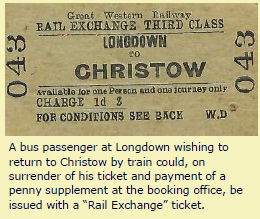
The officers' decisions took all this into account, as well as the small number of passengers likely to be attracted. Even if a halt had been built in 1936, many of its passengers would have been taken by the competing bus service introduced in 1947. The 1948 response also had this to consider.
Even then, road-rail interchange was possible, co-operation or co-ordination which is still to be fully rediscovered.
It is best not to make even an electrified railway like a tramway, with close and frequent stops, but to develop isolated stations and halts where possible into hubs from which light road vehicles radiate.
There are more files containing documents or photographs which will be of interest to railwaymen and enthusiasts, some of which are listed below.

Conicity
One of a series of films demonstrating first principles to those with an engineering bent.
The "party piece" which customarily is performed for visitors to the railway has been filmed in its full form and published on the Tube as "Conicity."
It was thought, perhaps hoped, that the novelty of this real demonstration would see it spread beyond the small circle that the Tube's system would automatically select. It was imagined that those with enquiring minds may pass it on to friends, with such comments as: "I can't quite see how this is done" or "this is intriguing."
But no such wider interest has been shown, in part perhaps because the types to whom this would ordinarily be of interest are not inclined, like effervescent youngsters would be, to share or make the small effort of clicking their approval, which it is believed would improve the ranking.
A link was posted on two local-interest Mughook pages, where it is noticed that every picture of a steam engine or diesel, no matter its relevance, captioned or not, receives a flurry of likes within minutes, while any snippet that requires a little concentration is soon overtaken and descends the column into obscurity.
When "Conicity" was met with the usual half-heartedness, the scribe was moved to comment:
"Really? Is this all I get: five likes and a handful of views for the effort involved? I had to turn three pairs of wheels, make a very tall dunce's hat (with a bit of HST piano hinge joining the two parts) and film a demonstration, unique to the Teign Valley. You will not see this done anywhere else. It is very disheartening that so many railway enthusiasts should show such indifference."
Once again, this wretched medium, with its horde of addicted, fanatical followers, showed that however tame the topic or small the interest, there will often be someone who has nothing useful or pleasant to say. "Conicity" proved to be no exception.
"Same principle as pulley profiles to stop belts from coming off. Nothing new. Its not surprising anyone shows indifference....... "
Why would a man who has not commented elsewhere and who does not understand the subject bother to make an entry? All he has done is let it be known on a public platform that he is both wrong and mean-spirited.
Fortunately, the kind comment from Hetty Prestiegne countered it.
"I for one was very impressed, the first time I had ever seen proof of a principle that had been explained to me."
Track recovery at Christow, 1959

Rather like the Grade One Clerical Officer posted in "The Cottage" at St. David's, part of whose duties was scanning local newspapers each day for mention of B.R., the junior clerk at Christow periodically does a trawl of the worldwide web using "Teign Valley Railway" as the search term.
While the 1960s' clerk became adept at completing crosswords and clipping coupons, it is thought that the junior clerk here is often distracted by some of the disgusting repositories found in the cyber cesspit.
Generally, the same million search results appear but recently a new one was espied: "Track recovery at Christow, July, 1959."
When the link came up, it showed a watermarked print of a negative that had just been sold.

The position of the photographer was unusual: he was standing near the footpath steps which mark the mid-point of the branch and no other shot taken from there has ever come to light. But the most surprising revelation was the diesel shunter dragging a track section down the Up Main, which it must have done for some way along the single line beyond.
The memory of a local fellow, who would have been only three at the time, that he had seen a diesel locomotive on a demolition train at Christow, dismissed by the scribe, is thus proven accurate. The scribe had understood that the track between Christow and Alphington had been lifted in 1958.
Further testimony came when members of the Cornwall Railway Society, on their way to visit Christow, had a chance encounter on the bus from Exeter.
"A fellow passenger proved to be an ex B.R. track worker from Ide who had been involved in the demolition of the 'Teign Valley line'. He lived in a cottage adjacent to the railway and one of his neighbours was a local driver and he related to me how they used to leave the 08 shunter and wagons outside their houses each night ready to start work again the next morning."
It is, then, almost certain that the line was lifted from Church Road Bridge, Alphington, working towards Christow, where recovered materials would have been loaded away. Some of the line had only recently been relaid and this track material is thought to have gone to Cornwall.
Reference to "wagons" is unclear. One method of recovering rails is to use an engine and a wire rope to draw them up and onto a bogie wagon whose brake is hard on. Sleepers would then be picked up manually or by such as a tractor with a fore-end lift and loaded on top of the rails.
Perhaps on the approaches to Longdown and Christow, complete sections were lifted, drawn onto the remaining track and dragged as seen in the photo. Perhaps they were dragged all the way, but then the wagons would have remained on the loops, where the crane could load them.

The models chosen for display in the Temporary Booking Office are not of those locomotives that were seen day in, day out, but the ones seen rarely, and then only in the dying days of the branch.
The four millimetres to the foot scale model of a D63XX, inspired by the shot of one in B.R. blue at Chudleigh Knighton in 1968, has now been joined by a seven millimetre diesel shunter.

The reliable old locomotives can be seen at work in these film clips: first, shunting a 1,000-ton train at Westbury; and second, coasting downgrade towards Midsomer Norton on the little of the S. & D. that has been rebuilt.


Heath Rail Link
A group aiming to revive the four miles of the former Moretonhampstead Branch between Newton Abbot and Heathfield.
Just as the few words were written on the previous section at the very end of February, 2020, an announcement appeared on Heath Rail Link's chatter page.
Suddenly, backers for the scheme had come forward, stirred by government's "Restoring Your Railway" fund. Sponsored by Teignbridge M.P., Anne Marie Morris, Teignbridge District Council had hurriedly prepared a bid for cash from the "Ideas Fund" and submitted it by the deadline of 28th February.
Making a good example of "distraction politics," the "Restoring Your Railway" fund promises £500-million to "drive forward," in the words of the rail minister, "the reversal of the controversial Beeching cuts."

The "Ideas Fund" is £300,000 and bidders' delegates will be made to pitch for a share of it in two rounds of a television-style knockout contest. As a feasibility study costs around £100,000, not many bidders will be successful. Lesser sums may be granted for exploratory work, but this will hardly be worth doing in all but a few cases.
Pitiful British transport policy is seen in action; or rather rail transport policy, because road policy continues without such drama as this. The road which corresponds with the old Moreton Branch, the A382, is undergoing "improvement" between Newton Abbot and Heathfield at a cost of £30-million, not so much to ease existing traffic but to provide for future growth. The path to setting this in motion was very different and has been trodden into a rut since the 1960s.
Government, if it were truly committed to rail expansion, could have done the same as when a national cycle network was wanted: in the absence of a plan of its own, it went to the people who did have one - Sustrans. Both of the national organizations, Railfuture and Campaign for Better Transport, have long had lists of lines deserving of reopening, vainly waiting for government to switch spending from motor roads to sustainable forms of transport. But, no, it is turned into some kind of mean ritual where toffs watch the poor scrabbling for coins tossed into the market square.
It can only be hoped, against all the odds, that Teignbridge's bid is successful in some way and that the course is set to reopen a third of the branch. But there is no presumption in favour of sustainable transport. Without relaxing the rules and expediting the process, any seed corn thrown by government is likely to be devoured by corvine consultancies in a feeding frenzy, whose only contribution will be to lay the ground for further studies.
The Moretonhampstead Branch, closed to passengers in 1959, was not a casualty of Beeching but what is left of the line can be considered for a grant as much as any other. The term "Beeching" is today used to describe the whole closure programme, which in Devon, post-war, started with the Princetown Branch in 1956 and finished upon the withdrawal of the passenger service between Exeter and Okehampton in 1972.
Heathfield - Newton Abbot Community Rail Project
Appendix: Extract from Heath Rail Link's postings
Charity HST Special, 10th October, 2015
Special Trains on the Moretonhampstead Branch

Last Run of the Albion
The end of Red Bus Services' contract
Richard Holladay provided the rare footage of a train coming off the Teign Valley Branch in Exeter, not far from where his family firm had established their works on land bought from the G.W.R. adjoining Canal Branch. His film is by far the most viewed on the railway's television channel.
Now he has kindly made available a film which is likely to prove equally popular. "Last Run of the Albion" captures his first vehicle at points along the route of the Exeter to Christow bus service in 1991.
Mr. Holladay started his company, Red Bus Services, in 1983 with an Albion Nimbus bought from Tony Hazel (later to become Carmel Coaches) for £150 a few years earlier. It had been part of the Devon General fleet until 1971.
Red Bus was awarded the contract by Devon County Council to operate the Exeter to Christow Service 360 in 1987. This was not strictly a "Rail Replacement" service because it had competed with the trains since 1947. It quickly took most of the railway's passengers and made possible closure of the line in 1958. In the words of the public notice posted at stations: "Passenger Road Services are already in operation in the area... ."

It is believed that the film was shot on the last day of the contract, Saturday, 24th August, 1991, when the Albion was rostered instead of more modern vehicles in the Red Bus fleet.
At this time, Devon Bus 360's ten Monday to Saturday through services covered the roads via Longdown and Dunchideock in both directions.
Lest any Teign Valley resident try to put names to the passengers in the opening scene, it must be stated that they were "extras" not there on the day; the sequence merely adds life to the film.
Mr. Holladay's Red Bus empire came to an end in 1997 but a thoughtful fellow could not let it go unrecorded for posterity. As well as writing the history of his family's firm, in which he played no part, he has penned "A History of Red Bus Services (East Devon)," a fascinating account of the mechanics, bureaucracy and day-to-day trials of running a local bus company. A copy is held at Christow Station and others may be obtained from Mr. Holladay by writing to the address below.
The Albion remains on the road, so it may be possible to re-enact this service for another film.

The Western in Western National
Between the wars, the Big Four railways acquired substantial interests in bus companies but tended to let them develop without much co-ordination between modes.
Western National was a joint venture by the Great Western Railway and the National Omnibus & Transport Company. Locally, the G.W. also had shares in Devon General.
If the period is thought of as having had good public transport, this is more because it was abundant; such co-operation as there was probably came only from parochial interest.
Deregulation aside, modern public transport has been refined in many metropolitan areas, although all bus services have to suffer congestion caused by the weight of self-centred transport.
In a turnaround of ownership, many passenger services on the disintegrated railway network are now run by bus companies under contract.
Rural bus services have been reduced or withdrawn over the years and the kind of network envisaged by this railway still figures only in the policy of the political party most concerned with the environment.
In the district of East Dartmoor, this would see the two branch railways forming the backbone, with compact buses—descendants of the Albion—mostly radiating from stations, gathering and dispersing train passengers as well as connecting the outlying settlements.
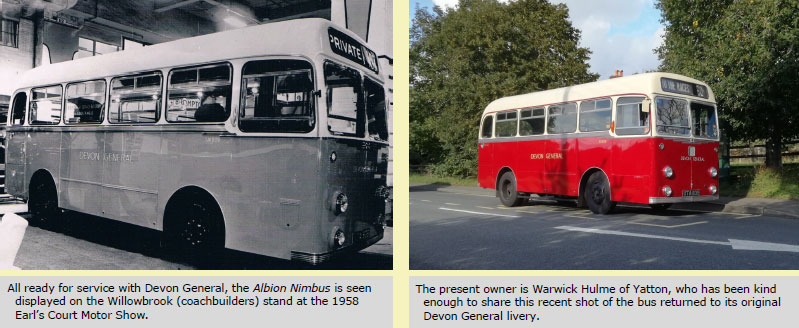
Mountain Mine
Underground side-tipping wagons sold to mining enthusiasts in Catalonia.
Never taken into stock after their recovery from the Watts, Blake, Bearne & Co. clay mines in the Bovey Basin, these trucks had only been used for stillage at Christow and it was rather hoped that they would one day have gone to Western United Mines at Pool (South Crofty).
The trucks are colloquially referred to as “UVs” and are intended for shafts and tunnels. The rim of the tub is less than an inch outside the wheels, which are independent and have tapered-roller bearings. These trucks have coupling pins but no buffer plate, as they were always rope-hauled.
Finally despairing of them ever going purposefully underground again, the three with original riveted Hudson bodies were advertised for sale.
There was some interest from home enthusiasts, but the best offer came surprisingly from Spain.
On 8th April, 2019, they were sent to Francesc of Associació Trens Miners Turistics (which it is thought translates as Tourist Mining Train Association). Snow prevented them reaching their new home at an old mine high in the mountains until May.
The trucks were sold as two-foot gauge but Francesc was advised that they would run happily on 600mm. (1ft. 11⅝in.).
No instructions were received prior to collection. It was thought unnecessary to put the trucks on pallets and instead laths were placed simply to keep the flanges off the ground and to stop the trucks rolling. These are still in place in the mountain road picture below.

These trucks last carried ball clay (whose residue can still be seen) from mines in the Bovey Basin.
Reaching the deposits from the surface put an end to underground mining in around 1998. Few ever knew that there were mines, even though the main road passed close to the adits. I was privileged in being taken down one of them in the late 1980s and I saw trucks like these (or maybe these very trucks) being loaded at a working face, four at a time, each with 12 cwt. Output was fifty tons a shift; on the surface the buckets were scooping up five tons at a time, but the better quality clays were not always available and there were seams of lignite (brown coal).
When I visited the clay museum at Norden (Isle of Purbeck clay came from Devon, there being no granite in Dorset), I told the lady on the gate how familiar I was with what I had seen. She asked if I was from Cornwall. It’s funny how Devon mining gets overlooked.
C.B.
https://www.facebook.com/trensminers/
January, 2021
It was decided in 2020 to sell a further four trucks. When the worst of the plague had passed, they were offered to Francesc in Catalonia, who quickly agreed to take them.
Shipping was more complicated, Great Britain having by this time left the European fold. It was necessary to obtain an E.O.R.I. (Economic Operator’s Registration and Identification) number, which was remarkably straightforward.
The trucks were collected on 23rd February and after some customs delay at the other end, they joined the other three on the mountain line.
Francesc requested a little history of the ball clay industry that employed his trucks and this was prepared and translated into Catalan.

The Permanent Way (and the Truth and the Life?)
It would be too sweeping to say that railways are the work of God and roads the creation of the Devil; but it could be said that there was something quite heavenly about a pretty country station, where the world appeared to be in order, and that there is something utterly hellish about the modern motor road, with its noise and filth and stink, and drivers that often seem to have protuberances on their foreheads.
What the scribe muses is brought down by his own experience, for he no longer finds much pleasure in train travel or any joy in lingering at stations, but fortunately still derives great enjoyment from cycling—on the roads. Roads in the old sense, that is: roads that are high ways; roads that are truly open; roads on which all are equal; roads that are politely shared; roads that are less travelled.
But the scribe still believes in and yearns for the country with trains and trams and omnibuses, the "faithful" country this could have been. And he is not alone.
Imagine his delight in coming across a lovely piece exploring the idea of a bond between religion and the railway, written by a most eloquent young diarist called Dominic Newman as part of his "Some Definite Service" pages.
The scribe could not help but reply, quoting some words of his own which he thought went with the theme.

Road-Rail Containers
The last of the pioneering first generation is gone.
In truth, not quite the last, for there is known to be at least a few more remaining elsewhere, but one of the last of the 50,151 containers owned by British Railways in 1959 was broken up at Christow in 2018.
The disadvantage, popularly associated with rail transport, of being in many cases unable to provide a service from door to door without handling, was solved in the 1920s by the introduction of the road-rail container, which could be lifted off a road trailer and placed on a flat railway wagon, and vice versa.
Those built by B.R. in the 1950s were not actually the first generation, but they differed little in their construction from the originals, being usually wooden framed and panelled with match-boarding or plywood.
The 27 types listed in the Standard Codes for Telegrams, 1958, were divided broadly into Type "A," small covered; "B," large covered; "C," small open; and "D," large open. The covered types were for general merchandise, but many were adapted for particular traffics and to traders' special requirements. Other types were ventilated or highly insulated; there was even a small one, "SW," on wheels that could be moved by hand.
Usually in very poor condition, these containers were still to be seen in the early 1970s. Among the last container traffic at St. David's was mail bags for H.M.P. Exeter, which would be delivered by a National Carriers small articulated lorry. By the mid 1970s, all of the old container types had been scrapped or sold. Hitachi bought some for its own rail traffic and had them suitably liveried.
Two were bought in 1976 for the project at Longdown. They were lying at Barton Hill, Bristol, but mysteriously turned up at St. David's on a freight train and were sold there for £25 each, plus 8% V.A.T.
7B30 18.55 Avonmouth - Ponsandane
18th March, 1976
A copy of the computer-generated train consist for the service that brought the railway's containers ex Bristol is in the archive at Christow. It is shown leaving Taunton at 21.15 with D1053, Western Patriarch, hauling 45 wagons and a brake van, a total of 976 tonnes. The containers are loaded on CONFLAT A wagons, consigned from Barton Hill to Exeter's mileage yard. The "commodity" was BADCON—condemned container—and the box numbers, not being on the system, were entered "free form."
The load includes three "payment" brake vans for Riverside Yard.
The locomotive was scrapped at Swindon in June the following year. Barton Hill shops is still open but Taunton’s Freight Concentration Depot is now a grotesque "condominium" cut through by the new Inner Distributor Road. And it would be a fair guess that every wagon on the train has been scrapped and that most of the men involved in the operation are now dead.
The "A"-type became a WORKBOX, in the style of the WORKVANs which once went from station to station—travelling workshops with men able to do building and furniture repairs as required. The "B"-type furniture container was used as a store, eventually surviving in the Teign Valley for 42 years, after only 19 years with B.R. Two more were bought in 1984 from East Yard in Taunton and were used as stores at Christow.
These old-fashioned containers leaked along seams and around the doors and so wettage was a common description of damage received at the claims offices. In many photos, containers are to be seen sheeted.
The railway's invention was the forerunner of the modern I.S.O. shipping container, which is to be found on rail, road and sea all over the world—and, thanks to one-way trade with the Far East, in countless yards and self storage depots across the country.
Because of the limitations of the B.R. standard loading gauge, which determines the profile of railway vehicles and their loads, eight-foot high—now 9ft.-6in.-containers were never carried on normal wagons, but instead on low, skeletal wagons operated in sets by B.R. offshoot, Freightliner, now a private company. In the U.S.A., containers can be loaded two-high. The B.R. gauge was so restrictive that even the old bow-roofed containers had to be centred on their wagons.

Although the design of the shipping container is vastly superior to the old ones, they cannot offer the same service as their predecessors without long-distance road haulage; the modern ones are loaded and offloaded by huge gantry cranes, reachstackers or forklifts at a small number of purpose-built depots. Whereas the first-generation boxes could have been handled here at Christow, and even in latter years at Exeter and Newton Abbot, the nearest Freightliner "Railport" is at Bristol, so that when modern containers are seen in the West Country, they will be on the back of a lorry.
Timber and fittings from the three old boxes have been incorporated in new work and it is hoped that the same will happen to material recovered from the last one to go.


Hixon-50 years on
"Automatic half-barrier crossings are one of the riskiest type of level crossings on the network—so it is important that drivers pay attention"*
It's been fifty years since the disaster at Hixon, on the West Coast Main Line, when an express collided with an "equipage" carrying a 120-ton, 16ft.-9in.-wide transformer on the newly-installed (April, 1967) Automatic Half Barrier level crossing.
The judicial enquiry that followed was ordered under Section 7 of the Railways Act, 1871; the previous enquiry under this legislation had been into the Tay Bridge disaster. The report ran to 146 pages and I read most of it after the anniversary.
Without stopping, the transporter driver, head of a five-man crew, had continued onto the crossing while the trailer steersman observed the clearance of the overhead wires. The driver saw the train coming and accelerated; the driver of the rear tractor put himself in danger by staying at the wheel. When the collision came it was with the swan neck part of the trailer. Fortunately, the front of the train was lightly loaded and casualties were not as bad as the wreckage might have suggested: eight passengers dead and 44 injured. The driver, secondman and a driver travelling on the engine were killed, and a steward was injured. The guard, a 49-year old, "never stopped running" for four miles, partly over rough ground, to protect both ends of his train.
It came to light that the transporter driver was completely ignorant of the functioning of A.H.B. crossings, despite a low-loader belonging to his firm, Robert Wynn & Sons, having had a very near miss at Leominster in November, 1966. B.R. failed in its response to this incident to insist on the telephone being used by drivers of abnormal loads and the managers of Wynn & Sons made no effort to acquaint themselves with the operation of the new crossings.
The Police escort had gone ahead to stop traffic. The officers were also unaware of the nature of the crossing and did not even know that it was a main line. The transporter driver followed Police, although it was entirely his responsibility to stop and telephone the signalman.
Because they are counter to established railway safe practice, I have always been uncomfortable with automatic crossings. It being proven that the line is clear, enshrined in Absolute Block and Track Circuit Block, is relaxed when there is an automatic crossing: the line may be blocked seconds before the approach of a train, without the safeguard of fixed signals to protect the obstruction. The elimination of risk becomes its acceptance; conversions of crossings were allowed on the judgement of the risk being very small. Of course, there had long been accidents at manned crossings and those without interlocking of signals held risk also, but there was always someone in attendance.
If it was assumed that the road user would come off worst in a collision, accidents at crossings would hardly have made any difference to the toll of road casualties, which in 1966 reached nearly 8,000 killed and nearly 400,000 injured.
When I was at boarding school in Taunton, my pals and I would often ride out to Victory or Bradford crossings, where there had not long before been signal boxes and gates, to watch trains. And on a still evening, having a fag behind the pavilion under Staplegrove Road bridge, trains could always be heard hooting twice in the distance; the report stated that half barrier crossings originally had "S.W." (whistle) boards.
One passage in the report surprised me. A B.R. officer, being questioned about the consideration given to abnormal loads when designing the crossings said: "The sort of thing they had in mind were those slow-moving vehicles such as Pickfords have on the road, the things that we sometimes use to carry our own dead steam locomotives." I'm sure that this was not the regular occurrence it is today and I cannot really see why it was necessary at all.
The whole thinking of A.H.Bs. was that motorists should not be delayed and that if they were delayed they might risk their lives by "jumping" the lights and dodging the barriers. Nowadays motorists are delayed everywhere, mostly by weight of their own numbers. With advances in technology, I think crossings should be proven clear by sensors interlocked with fixed signals and that heavy surveillance should be used to enforce discipline. For ultimate safety, it should not be too much to expect motorists to wait minutes instead of seconds at the barriers, an inconvenience we all have to put up with in many areas of our daily lives.

Out riding, I nearly always stop at an automatic crossing to savour the anticipation of the klaxon interrupting the quiet. The cub scout used to cycle to Athelney from school also, but then there was the watchful eye of a signalman and full barriers. The last time I was there, sitting on a wall, I could hear a train coming while a bus was approaching from Burrowbridge. The train "struck in," the lights began to flash and the bus stopped, by which time the train was in sight. It all worked as it should, but supposing that bus had been moments earlier and had stopped on the crossing. Perhaps it is the most unlikely event but imagine an H.S.T. driver seeing the obstruction ahead, knowing that the girders of the River Tone bridge lie just beyond.
Imagine the conversation between the men on the footplate of the electric loco at Hixon being cut short by the prospect of having seconds left before meeting their maker. Even if the other driver had been in the rear cab, he would have had time to slide back the window to see why the brake pressure had been destroyed.
There are only three half barrier crossings in Devon and the nearest to East Dartmoor is at Crannaford, on the now singled former Southern Railway main line from Waterloo to Plymouth. But the danger of this type of crossing was felt here very heavily in 2004.
A former occupant of Station House, Christow, returning from London had taken advantage of "weekend first," and found her seat, unusually, at the front of the train. A man had deliberately stopped his car on the automatic crossing at Ufton Nervet, where it was struck by the train causing complete derailment. The car driver, train driver and five passengers were killed. One was a 14-year-old girl from Doccombe, a pupil of the headmistress in first class, who was seriously injured. The girl’s father started a campaign for seat belts to be fitted and no one could dissuade a man so grief-stricken.
Fortunately, the risk of collision at Hixon and Ufton Nervet has been almost entirely eliminated because both crossings have been replaced by bridges. Athelney, Victory and Bradford remain on the Great Western’s Paddington to Penzance, via Westbury, main line where the permissible speed is 100 m.p.h., the maximum for this type of crossing.
C.B.
* From Network Rail's current guidance.
January, 2023: The chairman of the panel which investigated the incident at Leominster in 1966 stated that only the simultaneous but independent actions of the lorry driver and railway linesman had averted disaster.
The nearby linesman, seeing the low-loader grounded on the crossing, had rushed to the telephone intended for public use. As he was speaking to the signalman, the bells rang and the barriers were lowered. The oncoming loco-hauled passenger train had passed the distant signal at 90 m.p.h. but the signalman was able to set the home to danger. The combination of the train braking and the driver "bumping" the lorry clear meant that a collision was avoided by inches.
The Assistant Linesman was Jack Westwood. Fifty years after Hixon, his son, Richard, wrote "The Inside Story."
Inside the dustjacket are these words:
This is the shocking true story behind the botched introduction of Automatic Half-Barrier level-crossings into Britain.
January 1968 saw the convening of the first Parliamentary Court of Enquiry into a railway accident in Britain since the Tay Bridge Disaster nearly a century before. Why was this? Because Britain's 'Railway Detectives' the Railway Inspectorate, who would normally investigate all aspects of railway safety, were also in charge of the introduction of automatic Continental-style level-crossings into this country. At Hixon in Staffordshire, one of these newly installed 'robot' crossings on British Rail's flagship Euston to Manchester mainline, was the scene of a fatal high-speed collision between a packed express train and an enormous, heavily laden low-loader. For once, the 'Railway Detectives' were the ones having to explain their actions, in the full glare of media attention, to an expectant and increasingly worried nation. (There was another awful, fatal collision at an automatic crossing at Beckingham, Lincolnshire, in April of 1968).
Using previously undisclosed information, the author has been able to cast fresh light on not only the Hixon Disaster, but also the extraordinary story of the largely successful attempts, by British Railways and the Railway Inspectorate of the time, to hide the truth of just how close we came to having dozens of 'Hixons' right across the rail network.
"The Hixon Railway Disaster: The Inside Story" is published by Pen & Sword Transport
ISBN 9781473884434
The book may be ordered from The Bookery in Crediton. https://thebookery.org.uk/
An Automatic Half Barrier Crossing in operation at Victory, near Taunton
D6331

Of all the locomotives which may have been chosen to represent those that traversed the Teign Valley over the years, there is displayed in the railway's small exhibition room a model of the last—a wretched diesel.
The scramble to dieselize in the late 1950s, the only choice in the absence of electrification, threw up a host of manufacturers whose designs were introduced, unproven, onto a railway very much equipped and skilled for steam traction.
The North British Locomotive Company of Glasgow, a large and successful builder of steam locomotives, hastily tooled up to produce some of the early classes, one of which was a Type 2 (1,001—1,499 h.p.) diesel-hydraulic for the Western Region, commonly referred to as the "63."

Because the work was wanted for home manufacturers, small versions of reliable American locomotives (a course taken 30 years later) were shunned, yet North British chose the German M.A.N. engine, from the firm that had powered the U-boats, for the "63" and other locos.
Such was the haste implementing the B.R. Modernization Plan (1955) that even as faults in manufacturing and design were being revealed in pre-production locos, more were on order, and the "63" was no exception: the pilot six came out in 1959 while another 52 had been ordered in 1957.
The story of the "63" is but a small part of the tragedy of those momentous years, when the railway system which had remained almost at its greatest extent began to suffer dismemberment and the heavy bleeding of its traffic.
Not long after leaving the factory, the work for which the "63s" and other Type Twos were intended—stopping and branch passenger, and pick-up goods—was being lost.
And, rather like the Stephenson gauge winning over the broad, diesel-electric locomotives quickly outnumbered the hydraulics and B.R. standardized the former. North British went bust in 1962, partly under the weight of warranty obligations; there were also no new orders.

With spares harder to obtain, poor availability and less demand, the first "63" withdrawals occurred in 1967. Some lasted long enough to carry B.R.-blue livery but not the Class 22 numbers they were allocated. All were withdrawn by 1972 and none has survived.
In so many photographs of the period, the glum faces of "63s," their bodywork often in appalling condition, are captured in the last years or months of branch lines or small main line stations. They are seen assisting steam engines or themselves being rescued after they had failed by the old traction.
After passenger services were withdrawn, they are seen working residual freight traffic or collecting wagons on lines closed completely. Then, finally, there they are, locos with only a short life left, on the demolition trains.
It was "63s," not the tank engines that had served so well, hauling the last passenger trains on the Exe Valley Branch. And it was a "63" seen in one of the last pictures of the Teign Valley Branch in operation.
One of the last pictures of the Teign Valley Branch in operation
A group is intent on building a new locomotive, No. 6358.
http://project22society.co.uk/
Exeter Railway Junction
Freight train departure
A regular sight until a few years ago was a freight train working over the little that is left of the Teign Valley Branch, which penetrates Exeter's Marsh Barton Trading Estate.
The 138-ton locomotive could often be seen on the bridge over Marsh Barton Road (for many years restricted to all but diesel shunters), while rafts of 100-ton wagons were loaded with fragmentized scrap metal from the old Pearse's yard (now run by Sims Metal Management).
Trains could also be observed from Tan Lane and, while passing over Exeter Railway Junction, from the former Alphington Road Goods Yard (now occupied by The Range and Aldi). The film was shot from the car park at the latter place by Richard Holladay who has kindly allowed it to be published. If every wagon were fully laden, then the train, seen passing signal E131 at the start of its run to Cardiff, would weigh 1,730 tons.
The foundry of Mr. Holladay's family firm, Garton & King Ltd., was not far away, adjoining Canal Branch, the short loop which once passed beneath the main line to connect the Teign Valley with the City Basin Branch.
The story of Garton & King, an Exeter business which can be traced back to 1661, has been thoroughly documented by Mr. Holladay and should be read by anyone interested in the city's modern history.
http://www.exeterfoundry.org.uk/
Newquay Branch
Descending Luxulyan Bank
To dispel some of the myths attached to the working of "difficult" lines—such as that they could be used only by tiny trains—it was thought demonstrative to compare the closed Teign Valley to a railway still operational today, and the Newquay Branch, much of which originated as horse-drawn tramways, was chosen.
In particular, a journey along the branch between Pontsmill and Luxulyan, built by Cornish Minerals Railway in 1874 to replace a rope-worked incline, can give the passenger in a modern train a sense of what the line between Alphington and Christow was like.
It is not the same country but both lines share some characteristics: the woods; the high embankments and deep cuttings; the gradients and curves. In fact, the ruling gradient through the Luxulyan Valley is 1:40, more severe than any on the Teign Valley, and where once the exhaust crack of three steam locomotives may have been heard echoing as they lifted a heavy long distance train up the bank, diesel traction is now untroubled. The line speed here is 30 m.p.h.; on the difficult section of the Teign Valley Branch it was 35 m.p.h.
The poor quality film was shot from the front coach of a summer Saturday through train on a rare occasion when the formation was the reverse of the normal first class leading (so that businessmen and snobs can get to the barrier at Paddington before the third class throng), and captures the descent of most of Luxulyan Bank. Treffry Viaduct, which carried the original line, can be seen striding across the valley showing how much height has already been lost only a mile from Luxulyan Station.
Friends of the Atlantic Coast Line — Focal
Climbing Luxulyan Bank
Time was running out in which an H.S.T. could be taken to Newquay, so the E. & T.V.R. scout, instead of just making the return journey after a day’s cycling from a main line station, caught the 0857 S.O. Plymouth to Newquay on the Late Summer Bank Holiday weekend of 2018.
The service formed the 1130 S.O. Newquay to Paddington, The Atlantic Coast Express, the name given by the Southern Railway to its multi-destination holiday train, the last portion of which terminated at Padstow. This ceased in 1964 and the line was closed two years later, leaving Newquay as the only station on the north coast between St. Ives and Weston-super-Mare.
To balance the descent shot some years ago, the climb was filmed on this occasion starting at Ponts Mill, the foot of the incline, and continuing for around 2½ miles until foliage in the cutting beyond Luxulyan Tunnel began brushing the train. This is a little less than the distance between Ide and Longdown on the Teign Valley Branch, where the gradient is a mere 1:58. Were it not for the 30 m.p.h. restriction, H.S.Ts. would bound up the 1:37 of Luxulyan Bank.
Cornwall Minerals Railway built the line. The real Great Western Railway made Newquay into the popular holiday resort it remains today. British Rail designed and built the train. A grubby little train operating company, masquerading as old and honoured—which, when this sorry chapter of British railway history is played out, will become an embarrassing footnote—applied its garish vinyl wrap to the train.
At the end of the 2018 summer timetable, it is not clear whether this through working, which started with a Paddington to Newquay train in 1906, will continue next year. If it does, the London trains will almost certainly not be formed by H.S.Ts.
This is the end of an era for the E. & T.V.R. scout. He has been looking out of the same Beclawat droplights of Marks I, II & III carriages for most of his life. In this film, the camera captures the view that he would have had, looking along the bodyside of a 40-year old vehicle that may have covered 10-million miles, with his bicycle stowed in the space at the front.
May, 2019: The Hitachi "Inter-City Express Train," having been cleared for the route, commenced forming the summer through trains to Newquay.
Trackside on Luxulyan Bank: This short video captures a 650-ton excursion on the reverse curve beneath Treffry Viaduct, where the gradient and curvature is more severe than any on the Teign Valley. The train has a loco at the rear because there is no run-round loop at Newquay.
https://www.youtube.com/watch?v=8OJaZzjg4os
David Shepherd, C.B.E., F.R.S.A., 1931 - 2017
David Shepherd was best known as a wildlife artist and conservationist but he was also a railway enthusiast who, in the dying days of steam traction, captured perfectly, as only a painter could, the atmosphere of dilapidation and despair around the sheds and their locomotives, soon to be condemned.
A B.B.C. documentary, "The Last Days of Steam," has David Shepherd describing those end times when B.R. was turning out engines for their final turns. "Oh! Happy days, wonderful days. The sheer hell of doing it … a painting I did at Willesden Shed, the snow was coming through the roof and it was black by the time it hit the ground."
David Shepherd is introduced at 44m. 35s.:
https://www.youtube.com/watch?v=PWn4qkfPbd0&t=2797s
Incidentally, the narrator talks of B.R. continuing to build steam engines at 11m. 35s. while
the overhead crane moves an 0-6-0 diesel shunter's locomotive portion.
In the years when the railway's camping van was busy, a couple came to stay for three nights. I remember Gordon and his wife Cathie because he had been a B.R. manager and he told me how much responsibility was once given to quite low grades. One example of the work he undertook was commissioning a ship for the Channel Islands' tomato crop, which used to be landed in great quantities at Weymouth. Imagine detailing a bit of managerial fluff from First to such a task today.
Anyway, they may have said that they knew David Shepherd and that he would be keen to hear about my project. It was nevertheless still a surprise when a letter came from the great man a few weeks later.
Naturally, I had to thank him at length and this short exchange is my personal memory of the late artist. If only more men with his accomplishment and in his position could be as approachable and encouraging to the little fellow, instead of thinking themselves too high and mighty to be bothered.
Appendix: File of correspondence with David Shepherd
The Genus Grockle Automobilus
 The Plymouth Herald published an article in August, 2017, remembering B.B.C. reporter Keith Blackler's light-hearted glance at the Bank Holiday traffic chaos over Easter, 1973, in which he described "the migration of the grockles."
The Plymouth Herald published an article in August, 2017, remembering B.B.C. reporter Keith Blackler's light-hearted glance at the Bank Holiday traffic chaos over Easter, 1973, in which he described "the migration of the grockles."
There is now two and a half times the number of vehicles on the roads of Britain and they are driven further and more often, negating by a long way any improvement in efficiency.
Among the rust-prone death-traps seen trundling past in the news report, there is no equivalent to the modern wankmobile.
In the midst of his well-crafted commentary, Keith Blackler says:-
"But observers have also noted over the years that one small sub-species which effected their migration by train is very much on the decline, driven out by the sheer persistence of the motorized variety, rather as grey squirrels drove out the red. This variety, once numbered in millions, is now thought to be an endangered species likely to become extinct. It's all a question of changing environment: there aren't so many railways as there used to be, of course, and the roads are over-crowded. This suits the motorized grockle admirably. A well-known characteristic of their gregarious nature is a strange compulsion to go where all their mates are going and so the mysterious and little understood instinct which tells them that the roads of the South West will be choked with traffic serves only as an added attraction."
www.plymouthherald.co.uk/news/local-news/amusing-bbc-news-report-shows-335161
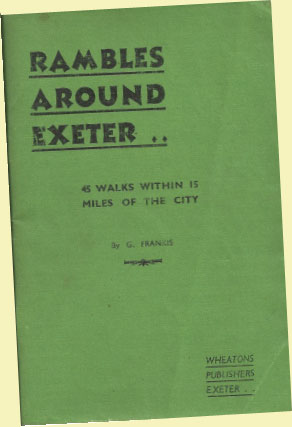
RAMBLES AROUND EXETER
Discovered by a good neighbour amongst the possessions of a departed soul was a small canvas covered book that could very easily have been discarded without a second glance. But a moment's curiosity revealed some walks from and to stations on the Teign Valley line and so the book was kindly loaned to the railway.
From the author's words, "as Exeter is re-built," and references to the railway companies' stations, the book must have been written in the late 'forties. It would certainly have conformed with the "economy standard" under paper rationing so it could have been published in the latter years of the war. One gazetteer puts it at 1949.
Published by A. Wheaton & Co. Ltd., the Paternoster Press, Exeter, the book's 88 pages contain a mere eight illustrations and one sketch map. The author, G. Frankis, began his Preface: "Around Exeter is a countryside of great variety, but always of surpassing richness and colour." He went on to say that he hoped to entice the walker beyond the main routes and encourage a better appreciation of "The Calm of the Countryside."
In contrast to almost every book of rambles on sale today, Frankis makes no mention of driving to the start of his walks; very few of his readers would have owned cars in the immediate post-war years and in any case only a few of his walks were circular.
Instead, he suggests modes of public transport: the train and bus. For some walks he suggests the bus when catching the train would be possible and vice versa. Anyone anywhere writing a walks' book twenty years later would not have been able to suggest the train as much, and this is true of walks within 15 miles of Exeter.
To summarize, Frankis suggests the train at one or both ends of 17 walks and in only three would that be possible today. In fact, train travel could have been used for the start of 29 walks and at the finish of 31; 22 walks could have involved the train at both ends. In only 14 of the walks would rail be of any use today.
There are six walks between Teign Valley Branch stations or halts and another using a single station. Eleven of the 45 walks could have started and, or, finished at Teign Valley stopping places.
Appendix: Summary List shewing Public Transport Options "Then" and "Now"
Some extracts which bring the Teign Valley line to life and touch on some minor historical details

DEVON GENERAL
OMNIBUS AND TOURING CO. LTD.
(in association with British Railways)
Once Busy Bus Stops
Leigh Cross and Teign House
Kept amongst the train timetables in the office at Christow is a supplement to the May, 1964, bus timetable, issued consequent upon services being transferred from Paul Street Bus Station to the new Paris Street in July of that year.
Mention of the Chagford service working via Leigh Cross in the Rambles item above, led to the scribe fetching out this supplement and thinking that some of its tables would be worthy of reproduction.

It can be seen that it was possible to travel from Christow to Chagford or Exeter and back on a Sunday afternoon. The outward journey to Exeter, the 1251 from Christow, involved changing at Leigh Cross into the 1220 Chagford, which departed at 1 5.

Service No. 20 was the Rail Replacement required as a condition of the line's closure and paid for by British Railways, hence its calling points were the former stations; Ashton and Trusham are not shown as stations but the timings seem too tight to allow the villages to be served.
"Down" departures from Christow at 8 7, 9 57, 2 7, 5 2 and 7 2 roughly correspond with those of the last train timetable of 1957, viz. 8 3, 9 58, 1 27, 5 7 and 6 38.
O.M.B. stood for "one-man operated bus." The end note read: "Services operated with "Pay as you enter" Vehicles and the co-operation of passengers is requested in having the fare ready on entering the Vehicle."
Note that Service No. 20 is not shown as O.M.B., so maybe a conductor was provided in place of the guard to help the old folk with their bags and the mothers with prams.

The service to Christow village was sparse at this time and its level was not much different from today's, which has suffered heavily as a result of government spending cuts. The overall service then and now was and is very much worse than it was at the peak at the turn of the century, when for three years, funded by a grant for rural services, today's 360 service was extended to Newton Abbot Station and there were five through workings in each direction. This, together with services 878 and 887, made the Teign House crossroads a busy bus stop; so much so that the railway prepared a simplifier for its campers wishing to get to the neighbouring villages.
The 5 55 Exeter still runs over 50 years later, only now working via Dunchideock instead of the main road, but still getting in at about the same time. Doddiscombsleigh now sees nine buses a day, whereas in 1964 there were only two.
In its day, Leigh Cross was a busy junction, too, and Mrs. Worth in the cottage there acted as Devon General Parcels Agent.

Searching for Albion
Island Story: Journeys Through Unfamiliar Britain by J.D. Taylor
"In the spirit of Cobbett, this is a beautifully written account of a journey around contemporary Britain which
is both political and poetic—a rare combination."
Anna Minton, author of Ground Control
To stay on the night of 15th September, 2014, came Dan, towards the end of his 111th day of a four-month cycling odyssey across the British Isles—Peckham to Christow, via Orkney and Scilly.
Unlike the chance meeting with Eve on her Buzz Tour, Dan had booked his night in TOAD from Manchester on the 79th day of his journey, having had the accommodation recommended by regular guest, Kirsty Garside. It was quite something that he still had to ride the Welsh coast and all the way from Bristol to Scilly before turning east, yet he rolled in at Christow on schedule.
Dan is the sort of intelligent company that is craved at Christow, to counter the crushing apathy of the "Lost Valley." He must have read some of these pages for he had a good grasp of the thinking behind the project and was curious to know more of the detail. The conversation continued the following morning and delayed his departure for Lyme Regis until midday.
Before he left, the fitter checked Dan's old Raleigh. Remarking on its weight, he put the rear wheel on the scales and they gave five stone (32 kg.). The E. & T.V.R. scout had ridden many of the same roads around the peninsular; when Dan spoke of his weariness at the sight of another hill, the scout could only think of that load.
What does a PhD scholar do before going to bed?
He writes 5,000 words on his blog, otherwise he can't sleep.
At this time, the worldwide telegraph was not connected to Christow and so when Dan turned up the purpose of his tour was not known. Later, when the scribe looked for him on the county library's computer, his pages were blocked by what the librarian advised was a very sensitive filter, possibly because of coarse language. Months afterwards, using uncensored access, Dan's writing was found and it was revealed that in the short time he was here he had got the story down in his cyberlog, which he had kept up all along the route every day. He must have been mentally and physically sapped when he finally made it back to his home in London.
The complete log, found at searchingforalbion.com, has now been distilled into a book, Island Story: Journeys Through Unfamiliar Britain, published by Repeater Books, a copy of which was ordered from Hive and collected from Crediton Community Bookshop.
https://searchingforalbion.com/2014/10/19/day-111-plymouth-to-christow/
https://searchingforalbion.com/2014/10/20/day-112-christow-to-lyme-regis/
Railway Nomenclature
In Great Britain, trains do not call at "train stations."
Rather browned off at hearing locomotives referred to as trains, the railway's scribe
attached a side label to the diesel shunter in an attempt to maintain usage of
established language.
Later, this was supplemented by a ruling on stations, as another alien term
became insinuated.
A photograph of the label now heads a campaign page on the worldwide
web and the scribe has added his own comments.
If these former hubs on an extensive and all-encompassing transport
system are to remain as little more than bus stops, as even the larger ones would be today if stripped of their coffee shops and shopping malls, then there is no harm done in letting "train station" and its like take hold.
For more than just tradition, though, should not railway station be maintained to remind everyone of what was once offered; to keep alive the image so as to inspire the young generation to agitate for a real railway to regain its position at the centre of all transport?

More terminology ...
Trains negotiate curves. There is no "S" bend on a railway; there is a reverse curve.
Trains ascend or descend gradients or inclines, which are rising or falling.
A locomotive is "in steam" if it is working (it is not so inaccurate to refer thus to an electric locomotive whose prime mover may be a steam turbine).
Trains have a head and a tail and can be hauled or propelled.
When is a car a railway carriage?
Another Americanism was long ago adopted with the arrival of the self-propelled carriage and is now used in relation to multiple unit trains. Dining, restaurant, buffet and sleeping cars were once common, too.
And when is a road a railway?
Although the Americans kept the original "rail-road," it became more of a slang term in Great Britain, the shortened "road" being more often used than "line."
As in a variation of the American SNAFU, with an Exeter Controller handing over at two o'clock on a summer Saturday: "All to hell on the down road, as usual." Or in P-Way men being paid double time on a Sunday, only if they "broke the road." Or in Terence Cuneo's classic painting, "Clear Road Ahead."
www.facebook.com/ItsNotTheTrainStationItsTheRailwayStation/?fref=nf
Visit by the Dartmoor Railway Supporters' Association
11th May, 2015
What was at first suspected as being a thinly disguised excuse to reconnoitre by agents from the Okehampton area turned out to be a friendly visit by eight enthusiastic railway promoters, again kindly arranged by Tony Hill.
Had D.R.S.A. members come to see what progress had been made on what they would call the "other" inland diversionary route, the word taken back to camp would have quelled any unease that the Teign Valley may have been further forward.
In the course of his preamble, the E. & T.V.R. guide pointed to a short length of the Up Main he had laid and remarked: "I'm only asking the state to do a thousand times more than I've done."
The proportionate figure for the Southern route would be far higher, no matter how much had been done by way of tokenism between Meldon and Bere Alston. But even the modest initial demand by the Okehampton interests for a reinstated weekday service on the existing line where there is proven need, almost entirely a paper exercise to bring about, languishes with all the other stalled schemes.
Not one chain of closed line has yet been reopened in the West Country.
The nearest to reconstruction is the Portishead Branch, only three miles of which needs relaying. The demand is pent up, the case cast iron and the formation almost complete, yet the exhaustive process drags on and prospective passengers must now wait until 2020 at the earliest to catch a train. What chance is there for lines further west without the sort of step change which brought the Borders to fruition?
It is a shame that more Dartmoor members could not have come but the conversations were lengthy with those that did, and the interest was deep, so the number was not at all disappointing. Anyway, a reciprocal visit by the Friends of the Teign Valley would muster even fewer.
The E. & T.V.R. wishes the Dartmoor stalwarts every success in their campaigning and will continue to support their most ambitious aims.
www.dartmoor-railway-sa.org/miscellany
The Railway—British Track Since 1804
Written by Andrew Dow and published by Pen and Sword Books, 2015.
In the concluding pages of his last book, a scholarly work celebrating the normally unsung engineer and permanent way man, the late Andrew Dow, always a staunch champion of the railway at large, wrote:-s
In 1920, 2,202,224,000 passengers travelled on the railways of the United Kingdom, this including the whole of Ireland. The figure includes 635,390,000 season ticket journeys. In the same year 4,802,000,000 passenger journeys were made on the tramways of the country. In other words, just over seven billion journeys were made on railed transport of various kinds, by a population of about 42.5 million, about two-thirds of today's figure. In addition, although it was not a peak year for freight, in 1920 Britain's railways carried 317,877,500 tons of freight, not far short of four times today's figure.
Robert Stephenson's London & Birmingham Railway was built in five years from 1833 to 1838 at a cost of £5.5 million. In today's terms, that equates to five years and £386 million. An early estimate for the HS2 line, in the first stage as far as Birmingham, was for it to take 14 years and to cost £32.5 billion. This enormous increase in time and money well illustrates the truth behind the words of Kevin Schieffer, writing inTrains magazine in January 2007: "A hundred years ago the challenge to build a railroad was a construction and engineering challenge. Today the challenge is just getting permission to do it."
Reproduced by kind permission of Pen and Sword Books Limited.
www.pen-and-sword.co.uk/The-Railway-Hardback/p/7846


September, 2017: In fact, the diminutive railway was spared for nearly two more seasons: the district council finally took possession of the land at the end of August, 2017.
There still being no development plans finalized, a motion was tabled at the town council to allow the funpark to continue for another year, as had already been granted for the Harbour View Café opposite, but this was not carried.
All of the equipment was then put up for sale by remote auction and the E. & T.V.R. scout went to view the loco and carriages, with the thought that possibly they may be useful as a sideshow at Ashburton. It was a chance to speak to Mr. Wright, whose family had run the funpark for donkeys' years, about the need to modernize a traditional seafront and the usual unsavouriness of local politicians.
The virtual hammer fell the following day and the railway's bid was very far short of the £6,000 paid for the train.
June, 2019: Stephen Derek, a former B.R. manager, who moved to Exmouth as a child in 1946, has kindly allowed these shots of the steam locomotive then operating on the circular Exmouth Miniature Railway to be shown. All he noted down on 7th October, 1962, was "4-4-2 No. 2003."

April, 2021: It was reported that the Exmouth Express loco and carriages had been rescued from a shed in Cornwall in 2020 by Henry Mock and Romy Langley, who planned to return the attraction to the council’s funpark on the front for the coming season.
A wire, with a link to this page, was sent to the couple. They replied, thanking the scribe for wished their venture well.
The scout rode by and had a look at the new Esplanade Station when the train was not there. Sadly, the track has been laid out of sight of Queen’s Drive. The couple have obviously made a very considerable outlay and it is hoped that Henry and Romy will be rewarded with success and a permanent way.
The track uses new 30 lb. (or the Napoleonic equivalent) flat bottom rail and includes what is thought to be a “transhipment” siding. The 100-yard line curves and goes off picture to the left.

https://exmouthminirail.co.uk/

From The Railway Magazine, February, 2016
It was good of Dave Rogers, 1st Take, to give the railway's spokesman a generous hearing. He had no idea beforehand what he was going to be asked or what exactly was required of him.
A Very British Map:
The Ordnance Survey Story
This excellent television documentary, part of the Timeshift series,
was first broadcast on BBC Four on 9th September, 2015.
Narrator (Lesley Manville): "Martin's* artistic rebranding cleverly coincided with the zeitgeist of the '20s and '30s. This was an era which saw increased leisure time for the lower middle classes and turned the stylish O.S. map into a must-have travel accessory."
Rachel Hewitt
Author, Map of a Nation
Narrator: "Many people's favourite series of O.S. maps, known as the Popular Edition, is from this era, published between 1919 and 1926.
Nicholas Crane
President, National Geographic Society
And, it could have been added, the time when the railway system was
at its greatest extent and Britain was the "Workshop of the World."

* Ellis Martin, the artist hired after the First World War by the Ordnance Survey to produce attractive covers for its maps to compete with the many pirated versions being sold.
The reader might have expected that the author of these pages would be an Ordnance Survey enthusiast.
Charity HST Special, 10th October, 2015
Rebekah Hartley vowed that she would recreate the trip she enjoyed with her late father in 1997, and here it is ...
The First Devon and Exeter Explorer
Paddington - Buckfastleigh - Heathfield - Buckfastleigh - Heathfield - Paddington
Buckfastleigh to Heathfield and back will run as a separate excursion for local passengers.
All bookings and enquires to the Branch Line Society.
It's a pity there couldn't be an "Ashburton Enquiry Special," with a nod to Mallingford in the classic Ealing comedy. The Dartmoor lot would of course hire Pearce & Crump.

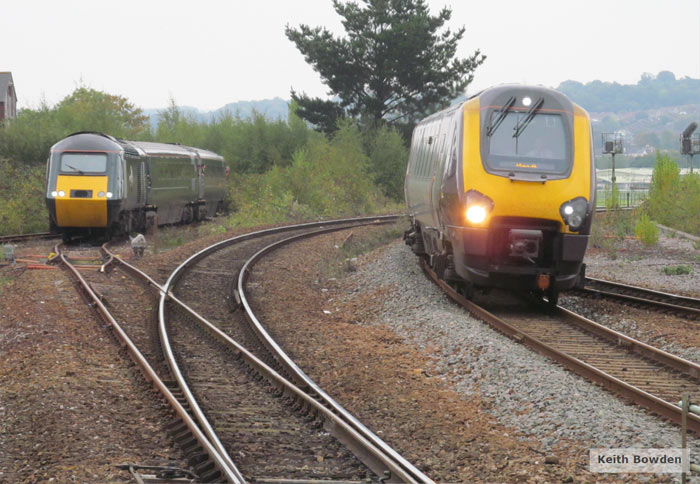
The 16.42 Heathfield to Paddington return charitex is seen at Moretonhampstead Junction awaiting the signal to proceed onto the Up Main. Most of the train is on the curve, the most severe on the whole line.
From where the train is standing, in 1957 it was possible to move directly to all the Newton Abbot station running lines as well as the branch bay: the Up Through, Up Main, Up Relief, Down Main, Down Relief and Down Through, serving eight platform faces. Those underlined remain and can be seen above.

David St. John Thomas, 1929-2014
In the year before he died, the well known author and publisher, David St. John Thomas, wrote to thank the railway for sending him a copy of A Journey in Time. Actually, the book must have been sent by someone else but anyway there was further contact and this letter was received, accompanied by a photograph taken on the last day of the passenger service, 7th June, 1958.

Roadpeace?
Can there ever be an end to belligerent behaviour on the roads while irresponsible manufacturers pander to the imbecile desires of impressionable men?
>> Transport for the High Achiever >>
Selling Tonka Toys to Toddlers at Christmas
and the "Gallery of Stupid."

Visit by the Dartmoor Society
13th May, 2015
The sun shone and it was the spring day—surely the very day—when the wild flower display was at its finest, bursting with colour and freshness.
Dr. Tom Greeves, rebel, folk leader, the founder and chairman of the Dartmoor Society brought 36 members to Christow for an afternoon visit, following the "railway debate" at Meldon Village Hall in October.
Most of the guests had a ride in Jenny Wren, the manumotive narrow gauge observation saloon, and all roamed the site, discovering its quirks and points of interest. Unfortunately, the diesel shunter was under heavy repair and GANGCAR was misbehaving, so there was not much movement on the standard gauge lines. A demonstration was given of "running-off" the motor trolley and some connections were made between Wickham, the maker, and Dartmoor.
Seemingly the most popular place as the afternoon went on was TOAD, the station buffet for the occasion, made possible by the kindness of two local ladies. Fiona brewed the Co-op's Fairtrade Indian Prince tea and served Rosalind's homemade cakes.
Closing his introductory remarks, in which he claimed that the "curvaceousness" of the Teign Valley line did not render it useless, Colin Burges, the owner, although not much one for anniversaries, pointed out that he began work on the project at Longdown Station on 13th May, 1975. He therefore thanked the society for giving him the excuse to get out the dressing-up box to mark the day.
Dr. Tom promptly sent a letter of thanks, saying (in part):-
On behalf of everyone, thank you so much for such a splendid afternoon on Wednesday.
I think all of us were astonished and delighted at what you showed us and what we saw. And it was serendipitously so special that we were there on your 40th anniversary!
You provided so much excellent information and demonstrated such fascinating engineering marvels that we're all dreaming trains!
Congratulations on what you have achieved—it's very special.
While the attitude towards the railway of the vast majority within the lost valley is, at best, steadfast indifference, it was again gratifying to find that interest and understanding comes from outside.
There is no Dartmoor society here but thankfully there is one beyond.
A Strange Place to Find a Shipwreck
The changed fortunes of the Western Morning News
After over 40 years almost unbroken subscription to the Western Morning News, Colin Burges gave up the paper in February.
Having been increasingly dissatisfied with the editorial style and standard of reporting, particularly during and after the Dawlish débâcle of 2014, the final straw was the refusal to publish the railway's letter of 4th February, countering yet more tosh on the subject of railway development.*
It has to be admitted that another major influence was cost. Without much by way of explanation, the price had gone up and up while the paper seemed to get smaller. Added to this was the delivery charge in the country, bringing the total to nearly £1 on weekdays. The days when advertisers as good as paid for most newspapers are gone, readers are told, although the publishers of Metro manage to give it away.
Funnily enough, one of the deciders was the introduction of a Sunday edition of the Western Morning News last year, which has never been seen here. Breaking the continuity by going without one edition led to questioning the value of the rest.
The paper claims that it has no allegiance to a political party or interest group, and this may be technically true. But it has become sickeningly such a mouthpiece for big business, clamouring for new roads, airports, science parks, housing estates and the rest, that far from protecting the uniqueness of the West Country, it would happily see it turn into an extension of the South-East, where everyone is so much more content. And there comes a point when a fellow can read not one more word about the wonders of rising house prices or any more self-congratulatory claptrap.

Since starting in business at Christow in 1995, never once has the paper picked up any stories supplied by the railway, which may have helped its position in some small way. Giles and Samantha who opened a bijou retro shop in St. Columb Major got a report. There was a half-page spread on some oddball who collected gnomes. On a slack day the editor did a piece on his vinyl record collection and feature writers, when short of copy, go on about their mid-life ailments or just "Google" a subject. But never was a column inch given to this railway and its letters were routinely mutilated to make them nonsensical.
The reader misses the feel of a newspaper in his hands, the randomness of the subjects, the differing opinions. He will miss clipping articles, trying to identify the place in the picture without reading the caption. He will miss the regular contributors, particularly Bendell, Coaker and Hesp, and the letter writers like good old Tony from Noss Mayo.
But, in the end, he says bollocks to the paper in its dingy squat in Millbay.
* There is ample criticism of the paper under Dawlish Débâcle.
Leicester Harmsworth House, the former headquarters and printworks of the Western Morning News and Herald, opened in 1938 on Frankfort Street, Plymouth, remained standing through the blitz of 1941, when most of its surroundings was flattened; so much so that after the war the building found itself on a new street.

It was said to be wholly inadequate to the needs of modern newspaper production and so a new, flamboyant headquarters was erected on a hillside at Derriford, north of the city. Nicholas Grimshaw (later Sir Nicholas), the architect responsible for the Eden biomes, chose a ship-like outline, with an engine room at one end housing the new colour presses, "decks" of open-plan offices and a boardroom "bridge" peering over The Sound and up to the moor. "The Ship" cost £33.5-million and was opened in 1993.
To begin with, an edition of the Daily Mail was printed here each evening, followed by the Western Morning News and other local titles. Then news publishing underwent another huge change, with plummeting circulations and advertising revenue forcing staff and production economies.
When the E. & T.V.R. scout cycled past in 2014, the presses had long before been taken away and a fellow clearing up the site said that latterly the staff had been rattling around in a half-empty building.
In 2013, after Daily Mail Group sold the Western Morning News, the new owner, Local World, rented a suite of offices in Millbay, opposite the site of the former S.D.R. terminus.
When the scout returned to Derriford in April, 2015, the place was deserted and the owner had by then applied to demolish it; the building was deteriorating, had a poor energy performance rating and was not readily divisible, so it was unsurprising that no buyer had been found.
At last, in May, Burrington Estates, a specialist at conversions, salvaged the wreck for £5-million.
Whether or not "The Ship" satisfies individual tastes, such buildings should be celebrated for their technical achievement, for the sheer brilliance of their construction. This is an outstanding creation which deserves a longer life.
The criticism here is that the outfit which twenty-odd years ago could not see where print journalism was going, now in a smaller space than Leicester Harmsworth House continues to spout endlessly about serious issues affecting the West Country, including what railways will be needed in a changing world.
Bovey Lane Crossing Saved

All that's left of the original Teign Valley Branch track between Marsh Barton and Heathfield
As part of the improvements to Bovey Lane and Accommodation Lane, a bridleway leading on towards Bovey and the Wray Valley, to make the route safer for pedestrians, riders and cyclists, Devon County Council planned to reduce the hump created by the railway embankment by about two feet, removing the embedded track in the process.
Residents of Haytor View, Heathfield, the terrace of houses built by Candy & Co. for its workers, were notified that work was to commence on 16th February.
Formidable spokeswoman for the little community and battle-hardened campaigner, Chris Mitchell immediately protested that the hump was not to be touched, for it deterred drivers from speeding and had historical value. She drew attention to the problem of increased traffic from Heathfield taking a short cut to the A38 since its junction with Old Newton Road had been closed.1
Her summary of the problems affecting Bovey Lane finished by pointing out that "the rails on the hump are the only rails of the Teign Valley line remaining" and quoting Devon County's own strategy for the Teign Valley which aims to "Protect the route of the disused Teign Valley Railway for potential reopening or recreational use."2

A site meeting was arranged for the morning of 10th February. Along came Chris with some Haytor View residents to meet County, District and Town Councillor, George Gribble, and Peter Burge and Ian James, project engineers responsible for delivering the cycle route as part of the "Granite and Gears" initiative.
The E. & T.V.R. scout, whom Chris had invited, fully expected that after a bit of an argument the work would go ahead regardless, but was pleasantly surprised when the very amenable council officers put the matter to Coucillor Gribble to decide, who said that he would bow to the local community's wishes.
And so the old level crossing will stay, subject to a safety review in a year's time.
1 Had the A38 been a railway, it would not have been able to sever Old Newton Road: a bridge or crossing would have had to have been provided when the line was constructed.
2 see www.devon.org
See also >> One of the last pictures of the Teign Valley Branch in operation >>

The situation at Bovey Lane is complicated now that there is an entrance and a road following the alignment of the branch to the scruffy "Station Park" trading estate. This has spoilt Bovey Lane, both by its presence and by the volume and type of traffic it has generated.
See >> Heathfield Station >>
This type of development so often springs up around stations and lines, but is seldom anymore connected with rail transport.
Here is another example that the E. & T.V.R. scout came upon this year while on a rural ride following part of the route of the Somerset & Dorset's main line from Bath to Bournemouth.
Where once the place resounded with railway activity, this being the junction of the Somerset Central's original line to Burnham-on-Sea, via Glastonbury*, with a branch to Bridgwater, now all that is left is a name and a railway curve fossilized in the walls and fences of an untidy access road.

Special Trains on the Moretonhampstead Branch
On Sunday, 21st. December, Rebekah Hartley* of First Great Western organized a special service of seven trains from Newton Abbot to Heathfield and back to raise money for Hannah's at Seale-Hayne, the pioneering charity that has worked with and championed disadvantaged and vulnerable children, young people and adults with a range of disabilities for more than 230 years.
The remnant of the Moretonhampstead Branch was billed as the "Teign Valley" for the occasion.
Members of the Branch Line Society and other enthusiasts were allowed to step off the last train of the day at Heathfield, which, upon its return to Newton, drew up at No. 9 Platform, the "Moreton Bay," before re-joining the main line.
The railway was kindly given a pitch in the booking hall at Newton.
Rebekah and her team of volunteers worked tirelessly all day and brought delight to lots of children of all ages.
On 25th March, a giant cheque for the sum of £4,864.94 was handed over at Seale-Hayne. A promise of £500 from Sibelco will bring the total raised to £5,364.94. Staff at Hannah's, receiving the donation with much gratitude, said that it was a quite remarkable achievement for one day's activity.
Rebekah is now planning this year's trains so her employers had better look sharp.
* Daughter of the late John Hartley (see "Kingskerswell Bypass")
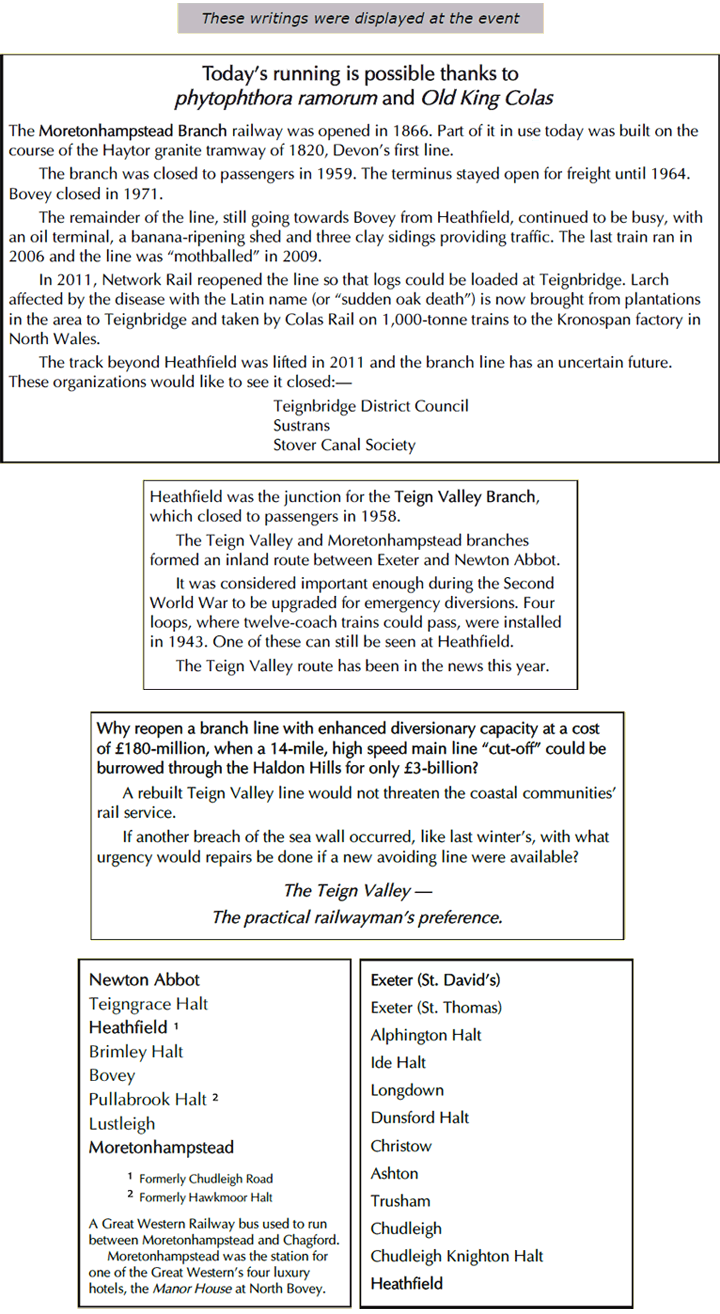




Dartmoor Society Public Debate, 2014
What future for railways and their heritage on Dartmoor?
This informal debate took place at Meldon Village Hall, not far from Meldon Junction and the viaduct, on Saturday, 11th October.
Dr. Tom Greeves, the charismatic Chairman of the Dartmoor Society, gave a very interesting talk about railway archaeology on the moor; Bernard Mills presented a wonderful slide show; Richard Searight of the Peninsula Rail Group argued the case for reopening the Southern main line to Plymouth; and Colin Burges rambled about the Teign Valley and railways in general.
Copies of this railway's report to Government and the stock leaflet, There were once 31 stations on and around Dartmoor, were handed out and many acquaintances were made.
The Dartmoor Society is planning a group visit to Christow in May.
After scoffing the leftover grub, in the remaining light of the day the E. & T.V.R. scout rode up the lane to the old main line and along to the viaduct, where he was once again awed by its height and slender construction.
Members of the Dartmoor Society visited Christow on 13th May, 2015.
The Buzz Tour
One of those happy coincidences that Lady Luck arranges occurred on Easter Monday, when the delightful Eve, walking the length of England "to pollinate change for a healthy environment," stopped off at Christow.
Having started at Totnes on the 11th April, she came across the station after calling at nearby Embercombe. She was surprised by what she found.
"I wasn‘t sure at first," she said. "But then I saw the crushed car."
A bringer of tidings from the land beyond the lost valley, she talked about the danger looming large for mankind and the much that is being done to counter it.
Though she had intended to continue further north that day, she was enticed by the railway‘s unique accommodation. TOAD being occupied, she was put up in TADPOLE, which was berthed by the river. The other, regular campers invited her to join their table for dinner.
This is the kind of hospitality she is hoping will be offered all along the way.
She is uplifting. Read about her purpose and follow her progress on www.buzztour.org11th July, 2015
This time on a bicycle, and having ridden non-stop from Totnes, Eve came to stay again for the first night of her new expedition.
Now fast becoming a celebrity, she is still humble enough to mingle with unexceptional people.
She was given chips and Tramp Juice and then she bedded down in TOAD. Her bike was checked before she set off the next day heading for Wells and encounters new.
A book, Pollinating Change, and documentary DVD record last year's adventure.
Caption Competition

Crediton Community Bookshop

The only independent bookseller serving Mid-Devon, Crediton Bookshop was taken over in September, 2013, and is now being run as a not-for-profit Industrial & Provident Society for the Benefit of the Community.
By combining up-to-date technology with the passion and knowledge of real book lovers, local bookshops provide a unique bookselling service. Even with the domination of Amazon and the development of e-books, local bookshops and particularly children's bookshops, continue to survive, even flourish. Unlike online selling of books, they provide high street havens of book culture, venues for literary events and where readers meet authors, and opportunities for face-to-face discussions with knowledgeable staff and other book lovers.
Crediton is fortunate in having a vibrant High Street with a significant number of independent retailers. In addition, the town boasts a very active Arts Centre, a bi-monthly farmers' market and, through Sustainable Crediton is part of the Transition Towns movement. There is a good train service from Exeter and a pleasant café at the station.
Objectives of the Bookshop
![]() To serve the community in Crediton and Mid-Devon with a self-sustaining, independent, local bookshop where excellent customer service takes priority
To serve the community in Crediton and Mid-Devon with a self-sustaining, independent, local bookshop where excellent customer service takes priority
![]() To provide an outstanding selection of children‘s books
To provide an outstanding selection of children‘s books
![]() To be the best resource for Devon writing including local authors, literature, history, geography, travel guides, maps etc.
To be the best resource for Devon writing including local authors, literature, history, geography, travel guides, maps etc.
![]() To promote reading and literacy in all age groups and provide a meeting place and focus for book lovers and local reading and writing groups
To promote reading and literacy in all age groups and provide a meeting place and focus for book lovers and local reading and writing groups
![]() To provide access to literary resources and specialist sales on the internet and through social media
To provide access to literary resources and specialist sales on the internet and through social media
![]() To promote the works of local authors, including self-published and specialist local books
To promote the works of local authors, including self-published and specialist local books
![]() To develop the shop as a Tourist Information Point which draws visitors
To develop the shop as a Tourist Information Point which draws visitors
https://www.youtube.com/watch?v=TtEjjLuh5b8
The only connection here is that at least one Teign Valley resident has become a shareholder. And, as far as he is concerned, it is great that, unlike other investments that have been lost, this one promised no monetary return.

the-teacher-and-the-bibliomotocarro-ape-put-wheels-on-books
In 2021 the shop was renamed "The Bookery." The space behind the shop has been developed and made accessible without having to use the open alleyway. It includes "The Hub," a flexible shared workspace and meeting area.

In 2025 share offer was enthusiastically taken up by the community and a large sum of money was raised, matched by a grant, to enable the bookshop to grow and to help it continue with its mission.
Teign Valley resident added £400 to his £120 earlier investment.
Heathfield - Newton Abbot Community Rail Project

2013: A campaign has begun to reinstate the passenger train service on the remaining four miles of the Moretonhampstead Branch.
Nothing more than is stated on the project's web pages is known.
The E. & T.V.R. sent a message of support in November and is prepared to join forces with any organization working towards a railway revival.
heathfieldcommunityrailproject.weebly.com/
As a matter of interest, word reached the railway that a Teignbridge Council officer* had telephoned a business on the Heathfield Trading Estate asking if any employees would benefit from improved cycle routes, in particular along the "old railway."
It has long been suspected that the railway's passage beneath the A38 dual-carriageway was identified as the preferred alternative to the dangerous pedestrian level crossing at the severed Old Newton Road.
This threat has more or less been lifted now that it has been announced that a new bridge is to be built as part of further road expansion at Drum Bridges.
Or so it was thought. See:-
>> Council leader wants remainder of Moretonhampstead Branch closed >>
* An enquiry at Forde House elicited that this was probably Chrissie Rowe, responsible for Green Spaces & Active Leisure. This has not been confirmed.
June, 2014: Before taking down the web posting, the organizer announced that owing to his work he had no more time to give to this campaign.
The organizer was Paul Beard, who is involved with a commendable campaign to reopen part of the Somerset & Dorset Railway‘s extensive network, the closure of which left great voids in the two counties not served by rail.
somersetanddorsetrailway.co.uk
2015: Interest was next shown by the Railway Reinstatement Association, which was set up to promote and lobby for the reopening of former railway branch lines using modern eco-friendly "Hybrid Rail" technology.
The story of the group's involvement with the Moretonhampstead Branch is told on its web pages and is reproduced here:
PLANS THWARTED FOR CONSORTIUM PROPOSING PASSENGER SERVICES
ON THE TEIGNBRIDGE BRANCH LINE
In 2015, one of the RRA's sponsors, Ecorail Ltd, along with the part owners of refurbished 139999, Lightweight Community Transport Ltd, had discussions with Network Rail Officials regarding the possibility of running a light rail demonstration service on a line in Devon— that, at just under four miles long and single track, is similar in length to the original Brentford line—which had recently been mothballed after a three year contract of just one train a week, due to the contract having been moved to larger facilities at Exeter.
Naively, Ecorail and its proposed partners were somewhat taken aback by the NR officials stating unequivocally that any changes to the line's status from freight to mixed traffic, change to speed limits and reopening of stations, would all require a substantial fee, just for NR to consider the proposals, with no guarantees of success. If undertaken separately, it would be in the region of £30,000 per issue.
It was made clear that there are considerable differences in legislative requirement on track standards between freight and passenger railways, and that any upgrade costs would fall on the proposed operators.
The situation was left that the partners needed to raise circa £100,000 for a feasibility study, that would almost certainly have come up with a figure of between £5– and £10-million, were a service even to be allowed. In view of this, Ecorail pulled out of the consortium as it felt that this level of investment on a line that they could only lease in short contracts, likely to be between seven and 15 years, would not allow time for the costs to be successfully amortised.
Later, a supporter of the remaining partners managed to get the Deputy Chief Inspector of Railways, Mr David Key to walk the line and give an opinion. This was that he could not sanction light rail running on the line as the track, in its current state, has places where it is so twisted that it would very probably derail light rail vehicles. So it would seem Ecorail's fear of necessary massive upgrades proved correct. No pleasure was taken from being right on this occasion.
http://railwayreinstatementassociation.co.uk/about%20us.html
A message of support from the railway went unanswered, as usual.
March, 2017: Not in the least deterred by the above account, the Newton Abbot to Heathfield Railway Revival Group was formed, led by enthusiast Mike Cooke. This could not have had less substance, yet has attracted press and television news coverage which has happily propagated the group's fanciful claims.
In a memo to one of the group known to the railway's scribe, he explained his position:-
"It pains me to be the dampener on all the spirit and enthusiasm shown for the four-mile rump of the Moreton Branch, but it is a case of having to accept hard reality. All around the country groups campaigning for station and line reopenings are getting nowhere. What I say is that they should all suspend their individual struggles and collectively press for government action to enable railways and tramways to be built. The greatest obstacles are entirely manmade and much more legislative than physical.
"Michael and his followers have done a fantastic job in drawing attention to the line and the reaction has been far greater than all my steady and rational campaigning over many years. Jeremy Christophers, the Teignbridge leader, who previously stated that he wanted the line ripped up, now supposedly supports its retention. Anne Marie Morris, who does not answer letters from me, says she supports the railway. Bovey Town Council, which doesn't speak to me, suddenly shows interest. British Ceramic Tiles ignored me but now says it wants a train service. Nigel Canham, a former Mid-Devon Advertiser reporter who lives in Christow, has never shown any interest in my work but has joined your group.
"But will anything materialize? My guess is that it won't. And sadly I can almost say how it will play out. There was a time when I would have joined the fray without hesitation, but now I have to be more measured and act where I can be most effective; I have wasted too much time and money on lost causes."
A message was also sent to Bovey Tracey Town Councillor, Tony Allen, from whom no acknowledgement has been received.
Appendix: Message to Bovey Tracey Town Council
February, 2020: The group is now called Heath Rail Link. Its Mughook page has a following of nearly 500 "supporters." A limited company has been formed with a share capital of £1. Numerous meetings have been held. To start with, members hope to be allowed to tidy Platform Nine, the former branch terminus at Newton Abbot.
On the last but one day of this leap year month, Teignbridge District Council submitted a bid to the "Restoring Your Railway" fund.
The continuing story: Heath Rail Link

It is not known how the junction sign (there was only one) beneath the running-in board on Heathfield's Up platform
came to
be re-erected in the grounds of Exeter School.
Parked in front of the station, partly obscured by the sign and the Teign Valley Bay buffer stop, is a Bedford van, in
crimson lake
and cream—"blood and custard"—livery with British Railways "double-bubble" transfer on the side panel.
Visit by the Branch Line Society
Sunday, 23rd June, 2013
"What we lack in length, we make up for with variety," was part of the brief opening announcement. For where else would anyone enjoy five short but different rides — and on the Teign Valley Branch?
 It has been some years since the Branch Line Society visited and again it was as much our pleasure entertaining 29 members, this time under the very capable leadership of Kev Adlam, who was working a tight diagram of fixtures over the weekend.
It has been some years since the Branch Line Society visited and again it was as much our pleasure entertaining 29 members, this time under the very capable leadership of Kev Adlam, who was working a tight diagram of fixtures over the weekend.
For a project that is shunned by the vast majority of those in the locality, it is always good when people from outside show such enthusiam and interest.
Kev was kind enough to follow up the visit with a very warm letter, thanking the railway for its effort.
The Temporary Booking Office
As the Teign Valley Branch train service obviously is not yet running, the waiting area of the newly-opened Temporary Booking Office has for now given place to part of a small exhibition of bits and pieces from days gone by.
The exhibition is intended to be of interest to the seeker of general and local knowledge, as well as to those particularly concerned with railways.
What anywhere else might be termed a “visitor centre” will also hold the railway’s educational and propaganda bumph and Gift Shop.
 The portable cabin which houses the Temporary Booking Office is positioned at the Sheldon Lane entrance, where it is meant to be inviting and accessible to visitors and passers-by.
The portable cabin which houses the Temporary Booking Office is positioned at the Sheldon Lane entrance, where it is meant to be inviting and accessible to visitors and passers-by.
Unfortunately, the only ticket the booking office will be able to issue at this stage is its souvenir Christow platform for admission. This costs £2 for adults and 50p for supervised children.
The exhibition should keep an intelligent person absorbed for at least half an hour and freedom to wander around the railway is included.
There will not be fixed opening times. Anyone planning a visit may telephone beforehand to check.
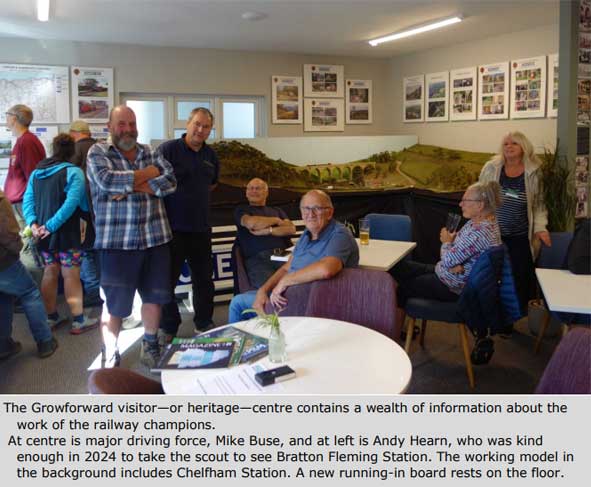


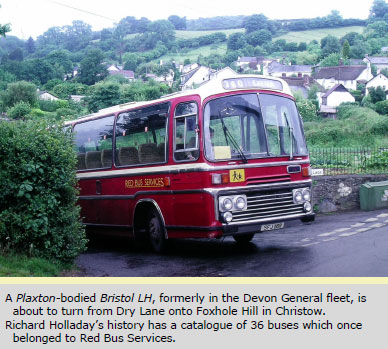

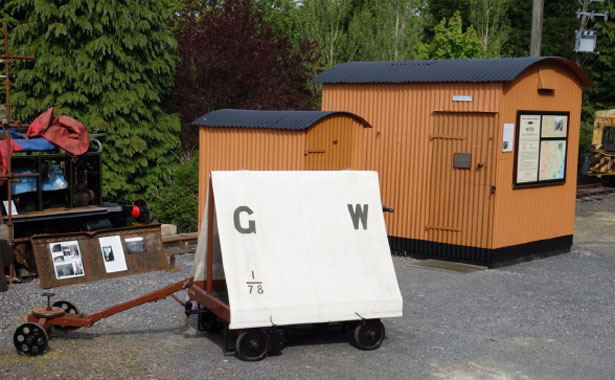
 Destination boards using "Rail Alphabet" were made up, the size being dictated by "Moretonhampstead," claimed to be the longest single station name in England (Is this true?). "Christow" was thought to be more appropriate than "Heathfield;" some trains did only go half way.
Destination boards using "Rail Alphabet" were made up, the size being dictated by "Moretonhampstead," claimed to be the longest single station name in England (Is this true?). "Christow" was thought to be more appropriate than "Heathfield;" some trains did only go half way. Souvenir E. & T.V.R. platform tickets were sold on the train and copies of a 1930 diversionary notice, with some explanation, were handed out.
Souvenir E. & T.V.R. platform tickets were sold on the train and copies of a 1930 diversionary notice, with some explanation, were handed out. This sad sight was countered to some extent by the ground being prepared at the former Teignbridge Sidings for the start of timber traffic, which would safeguard the branch for a few more years.
This sad sight was countered to some extent by the ground being prepared at the former Teignbridge Sidings for the start of timber traffic, which would safeguard the branch for a few more years.



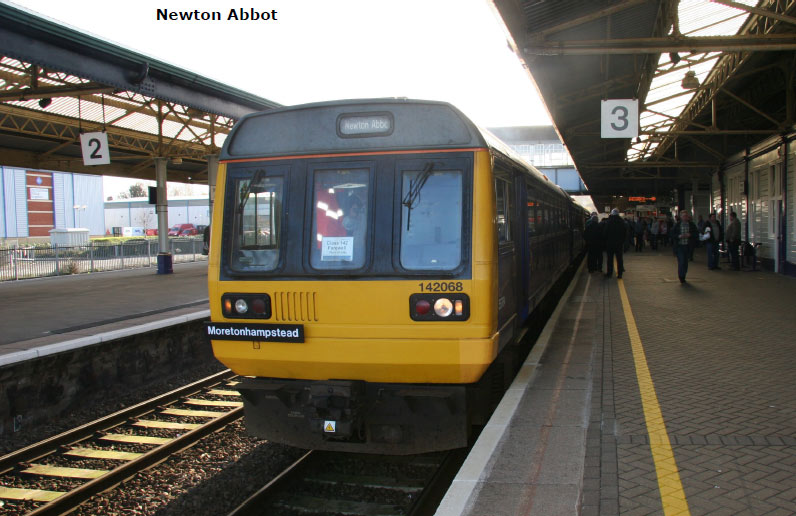

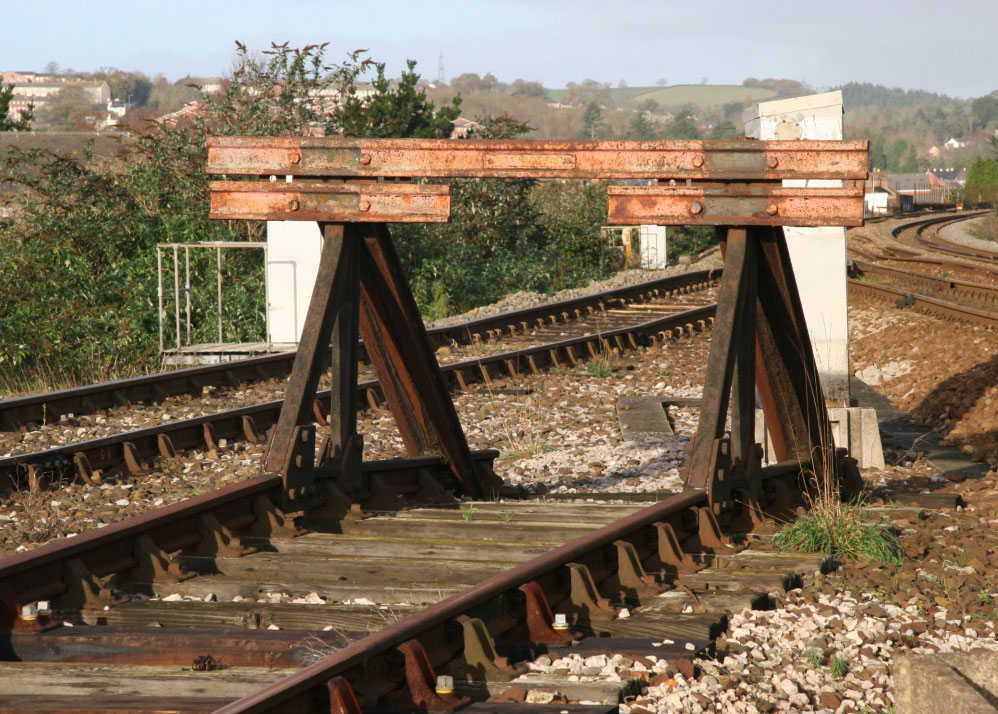

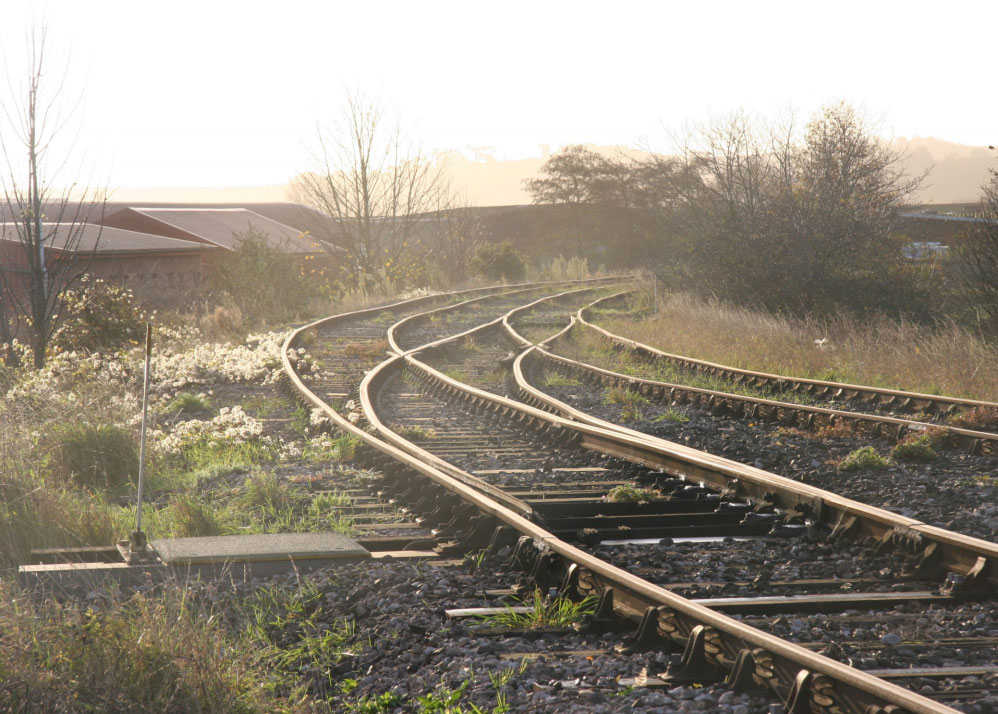



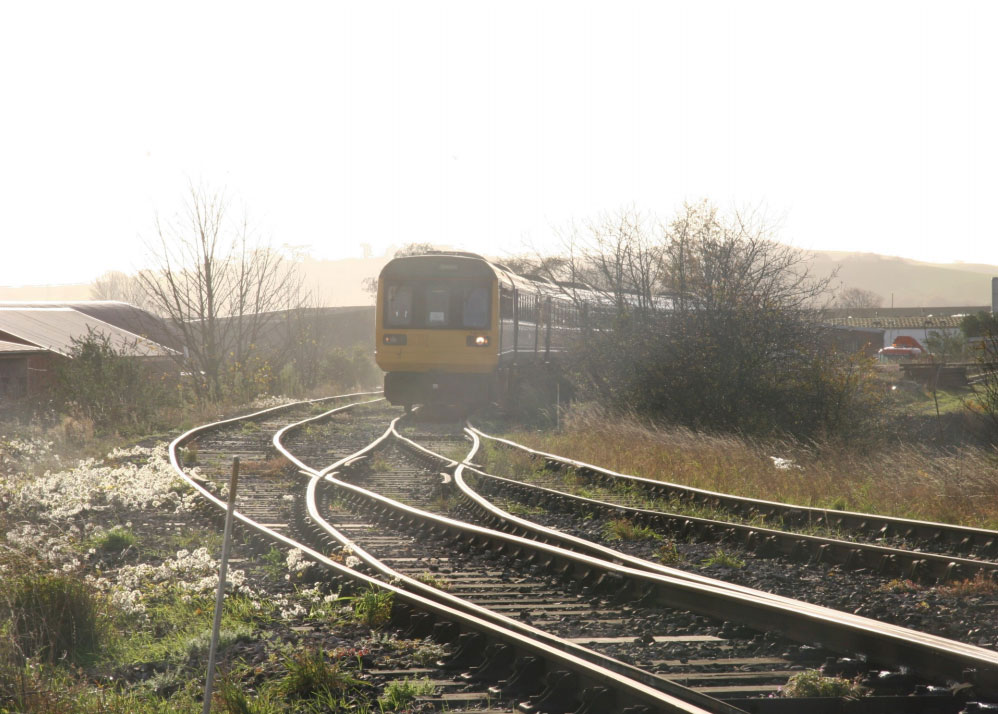









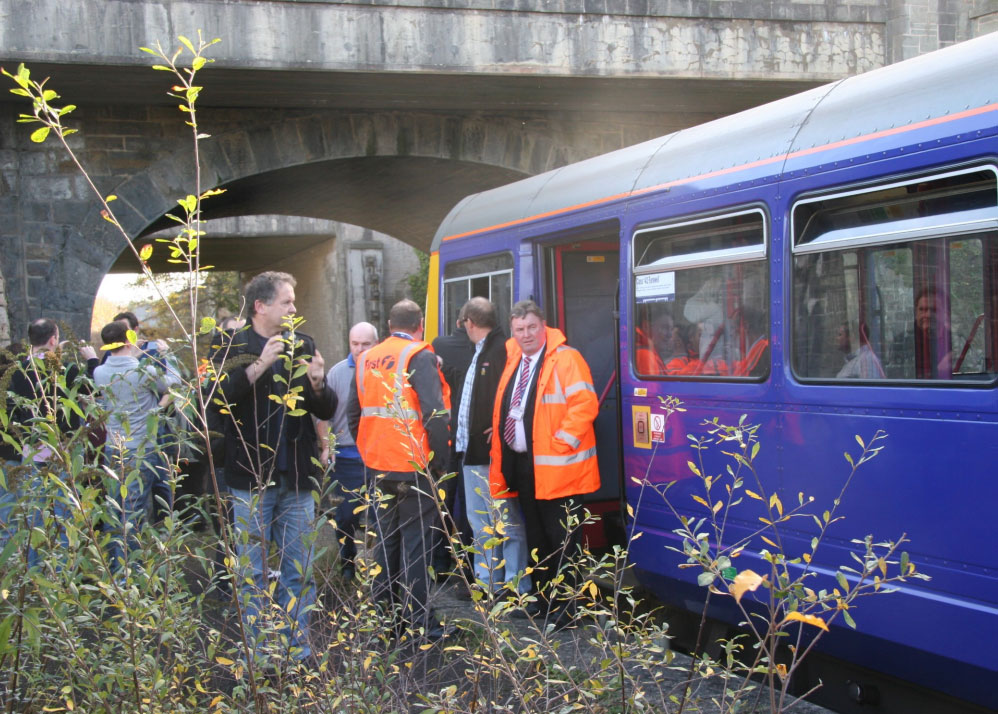







 Shortly after the Class 142 Farewell tour in November, 2011, timber traffic commenced at the place where ball clay was loaded from high platforms into 12-ton wagons for the potteries. This traffic ceased in the early 1980s and the loop sidings were lifted.
Shortly after the Class 142 Farewell tour in November, 2011, timber traffic commenced at the place where ball clay was loaded from high platforms into 12-ton wagons for the potteries. This traffic ceased in the early 1980s and the loop sidings were lifted.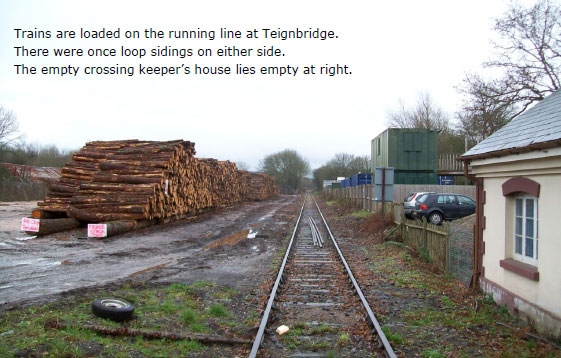 Although the traffic was only originating from Teignbridge, most of the line would come back into use as trains would work to Heathfield for the loco to run round. Unfortunately, this did not stop the remaining half mile being ripped up, leaving only an engine length beyond the station loop.
Although the traffic was only originating from Teignbridge, most of the line would come back into use as trains would work to Heathfield for the loco to run round. Unfortunately, this did not stop the remaining half mile being ripped up, leaving only an engine length beyond the station loop.


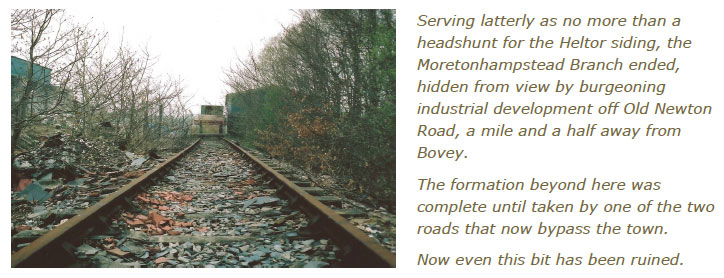
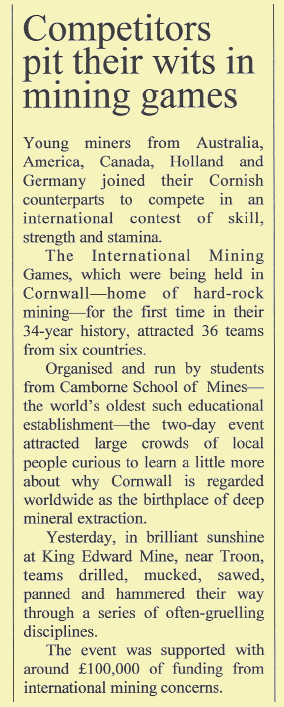

 The General Motors Class 66 hauling the train came abruptly to a halt—freight drivers do not worry about spilling the soup in the diner—on the Down Main, near to where the 1962, cedar-clad Exeter City Basin Junction signal box once stood. After setting back over the crossover onto the Up Main, the driver powered the special over the junction and onto the branch, the first loco-hauled passenger train since closure to passengers in 1958 (A D.M.U. had worked over the branch in 1972).
The General Motors Class 66 hauling the train came abruptly to a halt—freight drivers do not worry about spilling the soup in the diner—on the Down Main, near to where the 1962, cedar-clad Exeter City Basin Junction signal box once stood. After setting back over the crossover onto the Up Main, the driver powered the special over the junction and onto the branch, the first loco-hauled passenger train since closure to passengers in 1958 (A D.M.U. had worked over the branch in 1972). What remained of the Marsh Barton Trunk and the siding of E. Pearse & Co. was closed and the end of the Teign Valley Branch was given to the scrap yard so that wagons could be loaded on the embankment. Thus, the excursion could only proceed as far as the gates blocking the line, leaving the rear locomotive standing by what was Basin Loop Junction, where it was photographed.
What remained of the Marsh Barton Trunk and the siding of E. Pearse & Co. was closed and the end of the Teign Valley Branch was given to the scrap yard so that wagons could be loaded on the embankment. Thus, the excursion could only proceed as far as the gates blocking the line, leaving the rear locomotive standing by what was Basin Loop Junction, where it was photographed.




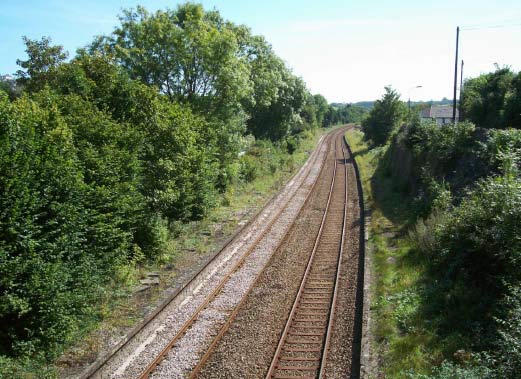



 The original sign at Ide was taken away in 1923 when the station was relegated to a halt and given a standard Great Western board.
The original sign at Ide was taken away in 1923 when the station was relegated to a halt and given a standard Great Western board.








